生理学核心词汇(中英对照)
- 格式:doc
- 大小:252.50 KB
- 文档页数:48
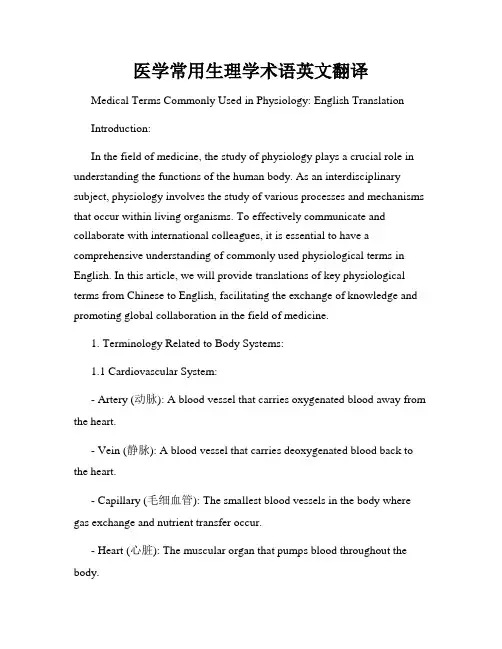
医学常用生理学术语英文翻译Medical Terms Commonly Used in Physiology: English TranslationIntroduction:In the field of medicine, the study of physiology plays a crucial role in understanding the functions of the human body. As an interdisciplinary subject, physiology involves the study of various processes and mechanisms that occur within living organisms. To effectively communicate and collaborate with international colleagues, it is essential to have a comprehensive understanding of commonly used physiological terms in English. In this article, we will provide translations of key physiological terms from Chinese to English, facilitating the exchange of knowledge and promoting global collaboration in the field of medicine.1. Terminology Related to Body Systems:1.1 Cardiovascular System:- Artery (动脉): A blood vessel that carries oxygenated blood away from the heart.- Vein (静脉): A blood vessel that carries deoxygenated blood back to the heart.- Capillary (毛细血管): The smallest blood vessels in the body where gas exchange and nutrient transfer occur.- Heart (心脏): The muscular organ that pumps blood throughout the body.- Blood Pressure (血压): The force exerted by circulating blood on the walls of blood vessels.1.2 Respiratory System:- Lung (肺): The organ responsible for gas exchange, supplying oxygen to the blood and releasing carbon dioxide.- Trachea (气管): The windpipe that connects the larynx to the lungs.- Bronchial Tube (支气管): Airways that branch off from the trachea, leading to the lungs.- Respiration (呼吸): The process of inhaling oxygen and exhaling carbon dioxide.1.3 Nervous System:- Brain (大脑): The control center of the nervous system, responsible for coordinating and regulating bodily functions.- Spinal Cord (脊髓): The bundle of nerves that extends from the brain and runs down the vertebral column.- Neuron (神经元): The basic building block of the nervous system, transmitting electrical signals.- Synapse (突触): The junction between two neurons, enabling the transmission of signals.2. Physiology Terminology:2.1 Homeostasis:- Homeostasis (体内平衡): The ability of an organism or system to maintain a stable internal environment despite external fluctuations.- Feedback Mechanism (反馈机制): A regulatory process that allows the body to maintain homeostasis through continuous monitoring and adjustment.2.2 Cellular Processes:- Metabolism (新陈代谢): The set of chemical reactions that occur within living organisms to maintain life.- Respiration (细胞呼吸): The process by which cells convert glucose and oxygen into energy, carbon dioxide, and water.- Diffusion (扩散): The movement of molecules from an area of higher concentration to an area of lower concentration.2.3 Hormonal Regulation:- Hormone (激素): Chemical messengers produced by glands that regulate various bodily functions.- Endocrine System (内分泌系统): A collection of glands that secrete hormones directly into the bloodstream.- Pituitary Gland (垂体): Often referred to as the "master gland," it controls the release of hormones from other glands.Conclusion:This article has provided translations of commonly used physiological terms from Chinese to English, allowing for effective communication and collaboration in the field of medicine. Understanding these terms is essential for medical professionals and researchers seeking to exchange knowledge on a global scale. By breaking down language barriers, we can facilitate the dissemination of scientific information and promote advancements in the understanding of human physiology.。
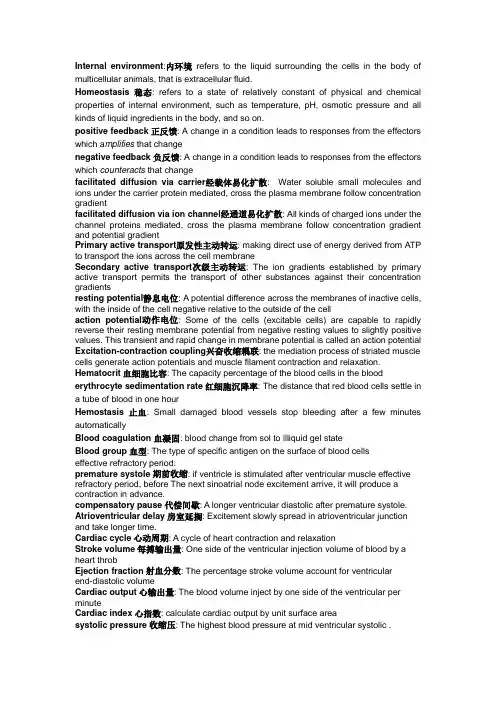
Internal environment:内环境refers to the liquid surrounding the cells in the body of multicellular animals, that is extracellular fluid.Homeostasis稳态: refers to a state of relatively constant of physical and chemical properties of internal environment, such as temperature, pH, osmotic pressure and all kinds of liquid ingredients in the body, and so on.positive feedback正反馈: A change in a condition leads to responses from the effectors which a mplifies that changenegative feedback负反馈: A change in a condition leads to responses from the effectors which counteracts that changefacilitated diffusion via carrier经载体易化扩散: Water soluble small molecules and ions under the carrier protein mediated, cross the plasma membrane follow concentration gradientfacilitated diffusion via ion channel经通道易化扩散: All kinds of charged ions under the channel proteins mediated, cross the plasma membrane follow concentration gradient and potential gradientPrimary active transport原发性主动转运:making direct use of energy derived from ATP to transport the ions across the cell membraneSecondary active transport次级主动转运:The ion gradients established by primary active transport permits the transport of other substances against their concentration gradientsresting potential静息电位: A potential difference across the membranes of inactive cells, with the inside of the cell negative relative to the outside of the cellaction potential动作电位: Some of the cells (excitable cells) are capable to rapidly reverse their resting membrane potential from negative resting values to slightly positive values. This transient and rapid change in membrane potential is called an action potential Excitation-contraction coupling兴奋收缩耦联: the mediation process of striated muscle cells generate action potentials and muscle filament contraction and relaxation. Hematocrit血细胞比容: The capacity percentage of the blood cells in the blood erythrocyte sedimentation rate红细胞沉降率: The distance that red blood cells settle in a tube of blood in one hourHemostasis止血: Small damaged blood vessels stop bleeding after a few minutes automaticallyBlood coagulation血凝固: blood change from sol to illiquid gel stateBlood group血型: The type of specific antigen on the surface of blood cellseffective refractory period:premature systole期前收缩: if ventricle is stimulated after ventricular muscle effective refractory period, before The next sinoatrial node excitement arrive, it will produce a contraction in advance.compensatory pause代偿间歇: A longer ventricular diastolic after premature systole. Atrioventricular delay房室延搁: Excitement slowly spread in atrioventricular junction and take longer time.Cardiac cycle心动周期: A cycle of heart contraction and relaxationStroke volume每搏输出量: One side of the ventricular injection volume of blood by a heart throbEjection fraction射血分数: The percentage stroke volume account for ventricularend-diastolic volumeCardiac output心输出量: The blood volume inject by one side of the ventricular per minuteCardiac index心指数: calculate cardiac output by unit surface areasystolic pressure收缩压: The highest blood pressure at mid ventricular systolic .diastolic pressure舒张压: The lowest blood pressure at ventricular end-diastolic.pulse pressure脉压: Systolic blood pressure minus diastolic blood pressurecentral venous pressure中心静脉压: The blood pressure in right atrium and chest cavity vena cavaMicrocirculation: Blood circulation between arteriole and micro veinEffective filtration pressure有效滤过压:the pressure difference between filtration and reabsorptionRespiration: The process of gas exchange between the body and its environmentvital capacity肺活量: After inhalation complete, the largest gas exhaled from the lungs forced vital capacity用力肺活量: After inhalation complete, exhale the largest gas from the lungs as fast as possibleforced expiratory volume用力呼气量: After inhalation complete, the gas exhaled from the lungs in a certain timeAlveolar Ventilation肺泡通气量: amount of inhaled the fresh air in the alveoli per minute. Pulmonary stretch reflex牵张反射: The reflection of inspiratory inhibit or inhale excited caused by pulmonary inflation and pulmonary deflation.Digestion消化: break down of food into small molecular components small enough to absorb.Mechanical digestion and chemical digestion.Absorption吸收: the small molecules that formed by digestion across the digestion tract mucosa go into blood and lymph.Small wave小波: the spontaneous rhythmic, subthreshold depolarization of the cell membrane of the gastrointestinal tract that characterizes the underlying electrical activity of the bowel.胃液主要成分1.HCl,parietal cell ,acid sterilization. Activation of pepsinogen, promotion of secretin secretion. Assisted effect of Fe and Ca absorption.2.Pepsinogen胃蛋白酶, chief cell, active in stomach, initially by H ions and then by active pepsin, autocatalytic activation. Pepsin an endopeptidase, which attacks peptide bonds in the interior of large protein molecules.3.Mucus粘液, neck cell and goblet cell, lubrication of the mucosal surface. Protection of the tissue from mechanical damage by food particle.4.intrinsic factor内因子, parietal cell. The intrinsic factor binds to vit B12 and facilitated its absorption.Stimulate gastric secretion刺激胃液分泌ACH gastrin histamine/ somatostatin Digestion phase gastric secretion消化期胃液分泌Cephalic gastric intestinal phase Regulation inhibitory gastric juice secretion胃液分泌抑制性调节1.HCl:inhibite G cell release gastrin;stimulate D cell release somatostatin;in the gastric antrum,inhibition of G cells,release of SST;in the duodenum ,release of secretin,bulbogastrone.2,fat:initiating release of enterogastrone.3,hepertonic solution:entero-gastric reflex.Receptive relaxation 容受性舒张:stimulation of receptor reflex muscle relax in the f undus and stomach body when chew and swallow.Pancreatic juice composition effect胰液成分作用:pancreatic amylase,pancreatic lip ase, trypsin,chymotrypsin,HCO3 bicarbonate balance the HCl in duodenum. Protect i ntestinal mucosa TPS and chymolase, pancreatic lipase, pancreatic amylase.Enteroh epatic circulation of bile salt.Bile salts were emptied into the small intestine with hepatic bile, about 95% is absorbed into the blood in the terminal ileum, and then synthesizing bile again after the hepatic vein to the liver, then empty into intestine.Physiological functions of bile胆汁生理作用1.Emulsifying or detergent function of bile salts.2.Help in the absorption of: fatly acid, lmonoglycerides, cholesterol, other lipids Peristalsis蠕动: the rhythmic waves of muscular relaxation and contraction are called peristalsis.Receptive relaxation 容受性舒张: stimulation of food on pharynx and esophagus produce relaxation of the lower esophageal sphincter and stomach.Gastric emptying胃排空: the process that the gastric contents are delivered to the duodenum.Thermal equivalent of food热价: calories liberated by 1g food oxidized in body. (kJ/g) Thermal equivalent of oxygen氧热价: heat production by consuming one liter of oxygen to oxidize a specific type of blood. (kJ/L)Respiratory quotient(RQ)呼吸商: in the process of oxidizing food, the ratio of CO2 produced to O2 used。
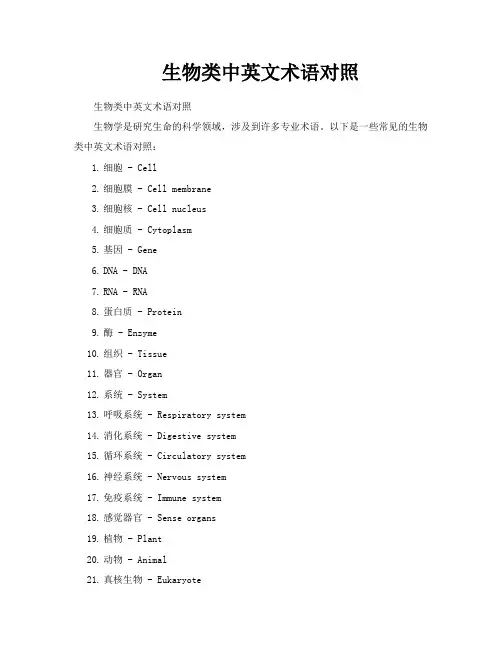
生物类中英文术语对照生物类中英文术语对照生物学是研究生命的科学领域,涉及到许多专业术语。
以下是一些常见的生物类中英文术语对照:1.细胞 - Cell2.细胞膜 - Cell membrane3.细胞核 - Cell nucleus4.细胞质 - Cytoplasm5.基因 - Gene6.DNA - DNA7.RNA - RNA8.蛋白质 - Protein9.酶 - Enzyme10.组织 - Tissue11.器官 - Organ12.系统 - System13.呼吸系统 - Respiratory system14.消化系统 - Digestive system15.循环系统 - Circulatory system16.神经系统 - Nervous system17.免疫系统 - Immune system18.感觉器官 - Sense organs19.植物 - Plant20.动物 - Animal21.真核生物 - Eukaryote22.原核生物 - Prokaryote23.进化 - Evolution24.自然选择 - Natural selection25.种群 - Population26.种 - Species27.物种多样性 - Biodiversity28.生态系统 - Ecosystem29.食物链 - Food chain30.生态位 - Ecological niche31.水生生物 - Aquatic organisms32.陆生生物 - Terrestrial organisms33.哺乳动物 - Mammal34.鸟类 - Bird35.爬行动物 - Reptile36.鱼类 - Fish37.節肢動物 - Arthropod38.昆虫 - Insect39.线虫 - Nematode40.软体动物 - Mollusk41.硬壳动物 - Crustacean42.植物分类 - Plant taxonomy43.界 - Kingdom44.门 - Phylum45.纲 - Class46.目 - Order47.科 - Family48.属 - Genus49.种 - Species50.进化论 - Theory of evolution51.遗传学 - Genetics52.基因组 - Genome53.遗传变异 - Genetic variation54.基因突变 - Gene mutation55.基因表达 - Gene expression56.遗传工程 - Genetic engineering57.克隆 - Cloning58.基因编辑 - Gene editing59.生物技术 - Biotechnology60.生物多样性保护 - Conservation of biodiversity61.细胞分裂 - Cell division62.有丝分裂 - Mitosis63.减数分裂 - Meiosis64.受精 - Fertilization65.胚胎 - Embryo66.胚胎发育 - Embryonic development67.遗传 - Heredity68.基因型 - Genotype69.表现型 - Phenotype70.遗传显性 - Dominant inheritance71.遗传隐性 - Recessive inheritance72.基因型比例 - Genotypic ratio73.表现型比例 - Phenotypic ratio74.自交 - Self-fertilization75.杂交 - Cross-fertilization76.光合作用 - Photosynthesis77.呼吸作用 - Respiration78.发酵 - Fermentation79.光合细菌 - Photosynthetic bacteria80.蓝藻 - Cyanobacteria81.植物生长 - Plant growth82.营养 - Nutrition83.吸收 - Absorption84.植物激素 - Plant hormones85.光周期 - Photoperiodism86.花期 - Flowering period87.叶绿素 - Chlorophyll88.光合作用速率 - Rate of photosynthesis89.光合产物 - Photosynthetic products90.光合产氧 - Oxygen production in photosynthesis91.繁殖 - Reproduction92.雄性 - Male93.雌性 - Female94.配子 - Gamete95.授粉 - Pollination96.传粉 - Pollination by animals97.结实 - Fruiting98.种子 - Seed99.胚 - Embryo100.发芽 - Germination这只是一小部分生物类中英文术语的对照,生物学领域的术语非常广泛。
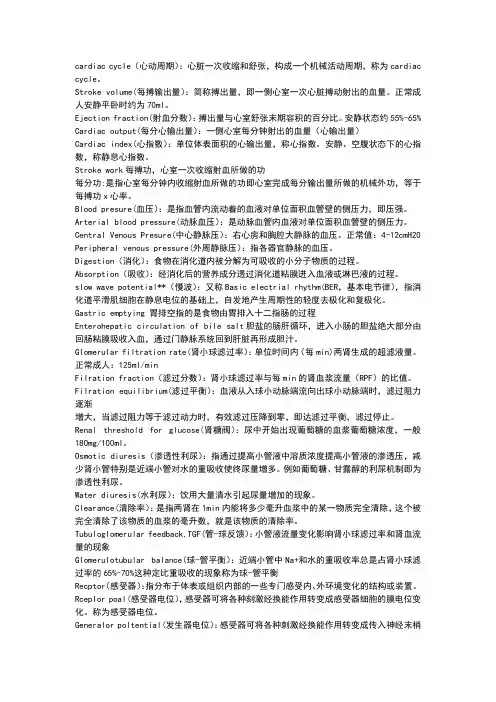
cardiac cycle(心动周期):心脏一次收缩和舒张,构成一个机械活动周期,称为cardiac cycle。
Stroke volume(每搏输出量):简称搏出量,即一侧心室一次心脏搏动射出的血量。
正常成人安静平卧时约为70ml。
Ejection fraction(射血分数):搏出量与心室舒张末期容积的百分比。
安静状态约55%-65% Cardiac output(每分心输出量):一侧心室每分钟射出的血量(心输出量)Cardiac index(心指数):单位体表面积的心输出量,称心指数。
安静、空腹状态下的心指数,称静息心指数。
Stroke work每搏功,心室一次收缩射血所做的功每分功:是指心室每分钟内收缩射血所做的功即心室完成每分输出量所做的机械外功,等于每搏功x心率。
Blood presure(血压):是指血管内流动着的血液对单位面积血管壁的侧压力,即压强。
Arterial blood pressure(动脉血压):是动脉血管内血液对单位面积血管壁的侧压力。
Central Venous Presure(中心静脉压):右心房和胸腔大静脉的血压。
正常值:4-12cmH20 Peripheral venous pressure(外周静脉压):指各器官静脉的血压。
Digestion(消化):食物在消化道内被分解为可吸收的小分子物质的过程。
Absorption(吸收):经消化后的营养成分透过消化道粘膜进入血液或淋巴液的过程。
slow wave potential**(慢波):又称Basic electrial rhythm(BER,基本电节律),指消化道平滑肌细胞在静息电位的基础上,自发地产生周期性的轻度去极化和复极化。
Gastric emptying 胃排空指的是食物由胃排入十二指肠的过程Enterohepatic circulation of bile salt胆盐的肠肝循环,进入小肠的胆盐绝大部分由回肠粘膜吸收入血,通过门静脉系统回到肝脏再形成胆汁。
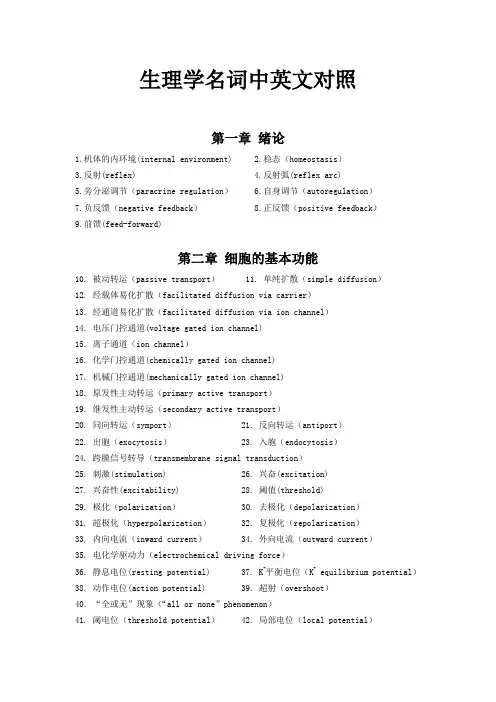
生理学名词中英文对照第一章绪论1.机体的内环境(internal environment)2.稳态(homeostasis)3.反射(reflex)4.反射弧(reflex arc)5.旁分泌调节(paracrine regulation)6.自身调节(autoregulation)7.负反馈(negative feedback) 8.正反馈(positive feedback)9.前馈(feed-forward)第二章细胞的基本功能10. 被动转运(passive transport) 11. 单纯扩散(simple diffusion)12. 经载体易化扩散(facilitated diffusion via carrier)13. 经通道易化扩散(facilitated diffusion via ion channel)14. 电压门控通道(voltage gated ion channel)15. 离子通道(ion channel)16. 化学门控通道(chemically gated ion channel)17. 机械门控通道(mechanically gated ion channel)18. 原发性主动转运(primary active transport)19. 继发性主动转运(secondary active transport)20. 同向转运(symport) 21. 反向转运(antiport)22. 出胞(exocytosis) 23. 入胞(endocytosis)24. 跨膜信号转导(transmembrane signal transduction)25. 刺激(stimulation) 26. 兴奋(excitation)27. 兴奋性(excitability) 28. 阈值(threshold)29. 极化(polarization) 30. 去极化(depolarization)31. 超极化(hyperpolarization) 32. 复极化(repolarization)33. 内向电流(inward current) 34. 外向电流(outward current)35. 电化学驱动力(electrochemical driving force)36. 静息电位(resting potential) 37. K+平衡电位(K+ equilibrium potential)38. 动作电位(action potential) 39. 超射(overshoot)40. “全或无”现象(“all or none”phenomenon)41. 阈电位(threshold potential) 42. 局部电位(local potential)43. 时间性总和(temporal summation) 44. 空间性总和(spatial summation)45. 量子释放(quantal release)46. 兴奋-收缩耦联(excitation-contraction coupling)47. 等长收缩(isometric contraction) 48. 等张收缩(isotonic contraction)49. 前负荷(preload) 50. 后负荷(afterload)51.肌肉收缩能力(contractility) 52.不完全强直收缩(incomplete tetauns)53.完全强直收缩(complete tetanus) 54.运动单位(motor unit)第三章血液55. 血细胞比容(hematocrit) 56. 血浆渗透压(plasma osmotic pressure)57. 血浆晶体渗透压(plasma crystal osmotic pressure)58. 血浆胶体渗透压(plasma colloid osmotic pressure)59. 悬浮稳定性(suspension stability)60.红细胞沉降率(erythrocyte sedimentation rate)61.红细胞渗透脆性(osmotic fragility) 62.血小板黏附(platelet adhesion)63.血小板聚集(platelet aggregation) 64.生理性止血(hemostasis)65.出血时间(bleeding time) 66.凝血时间(clotting time)67.血液凝固(blood coagulation) 68.血清(serum)69.凝血因子(clotting factor) 70.内源性凝血途径(intrinsic pathway)71.外源性凝血途径(extrinsic pathway) 72.纤维蛋白溶解(fibrinolysis)73.血型(blood group) 74.红细胞凝集(agglutination)75.凝集原(agglutinogen)76.凝集素(agglutinin)77.交叉配血试验(corss-match test)第四章血液循环78. 心动周期(cardiac cycle)79. 等容收缩期(period of isovolumic contraction)80. 等容舒张期(period of isovolumic relaxation)81. 每搏输出量(stroke volume)82. 射血分数(ejection fraction)83. 心输出量(cardiac output)84 心指数(cardiac index)85. 异长调节(heterometric regulation)86.心室功能曲线(ventricular function curve)87.心肌收缩能力(myocardial contractility)88.等长调节(homometric regulation)89.快反应细胞(fast response cell) 90.慢反应细胞(slow response cell)91.期前收缩(premature systole) 92.代偿间歇(compensatory pause)93.自动节律性(autorhythmicity) 94.正常起搏点(normal pacemaker)95.潜在起搏点(latent pacemaker) 96.异位起搏点(ectopic pacemaker)97.房室延搁(atrioventricular delay)98.膜反应曲线(membrane responsiveness curve)99.钙触发钙释放(calcium-induced Ca2+ release)100.外周阻力(peripheral resistance)101.动脉血压(arterial blood pressure)102.收缩压(systolic pressure)103.舒张压(diastolic pressure) 104.平均动脉压(mean arterial pressure)105.中心静脉压(central venous pressure)106.微循环(microcirculation) 107.压力感受性反射(baroreceptor reflex)第五章呼吸108.肺通气(pulmonary ventilation) 109.肺换气(gas exchange in lungs)110.呼吸运动(respiratory movement) 111.弹性阻力(elastic resistance)112.顺应性(compliance) 113.肺的静态顺应性(static compliance)114.比顺应性(specific compliance) 115.肺表面活性物质(pulmonary surfactant)116.气道阻力(airway resistance) 117.潮气量(tidal volume)118.余气量(residual volume)119.功能余气量(functional residual capacity)120.肺活量(vital capacity) 121.用力肺活量(forced vital capacity) 122.用力呼气量(forced expiratory volume)123.肺通气量(pulmonary ventilation)124.解剖无效腔(anatomical dead space) 125.肺泡无效腔(alveolar dead space) 126.肺泡通气量(alveolar ventilation)127.通气/血流比值(ventilation/perfusion ratio)128.血氧容量(oxygen capacity) 129.血氧含量(oxygen content)130.血氧饱和度(oxygen saturation) 131.氧解离曲线(oxygen dissociation curve) 132.肺牵张反射(pulmonary stretch reflex)第六章消化与吸收133.消化(digestion) 134.机械性消化(mechanical digestion)135.化学性消化(chemical digestion) 136.吸收(absorption)137.慢波(slow wave) 138.胃肠激素(gastrointestinal hormone)139.脑-肠肽(braingut peptide)140.黏液-碳酸氢盐屏障(mucus bicarbonate barrier)141.胃黏膜屏障(gastric mucosal barrier)142.容受性舒张(receptive relaxation)143.紧张性收缩(tonic contraction) 144.胃的排空(gastric emptying)145.肠-胃反射(entero-gastric reflex) 146.分节运动(segmentation contraction)147.胆盐的肠-肝循环(enterohepatic circulation of bile salt)第七章能量代谢与体温148. 能量代谢(energy metabolism)149. 食物的热价(thermal equivalent of food)150. 氧热价(thermal equivalent of oxygen)151. 呼吸商(respiratory quotient) 152. 基础代谢率(basal metabolic rate) 153. 体温(body temperature) 154.温热性发汗(thermal sweating)155.精神性发汗(mental sweating 156.热敏神经元(warm-sensitive neuron) 157.冷敏神经元(cold-sensitive neuron)第八章尿的生成和排出158. 管-球反馈(tubuloglomerular feedback)159. 肾小球滤过率(glomerular filtration rate)160. 滤过分数(filtration fraction)161. 有效滤过压(effective filtration pressure)162. 肾糖阈(renal threshold for glucose)163. 葡萄糖吸收极限量(transfer maximum of glucose)164. 渗透性利尿(osmotic diuresis)165. 球-管平衡(glomerulotubular balance) 166. 水利尿(water diuresis) 167.清除率(clearance)第九章感觉器官的功能168. 感受器(receptor) 169. 感觉器官(sense organ)170. 适宜刺激(adequate stimulus) 171. 换能作用(transducer function)172. 瞳孔对光反射(pupillary light reflex)173.互感性对光反射(consensual light reflex)174. 瞳孔近反射(near reflex of the pupil)175.视敏度(visual acuity)176.暗适应(dark adaptation) 177.明适应(light adaptation)178.视野(visual field) 179.听阈(hearing threshold)180.耳蜗内电位(endocochlear potential)181.耳蜗微音器电位(cochlear microphonic potential)182.眼球震颤(nystagmus)第十章神经系统的功能183.突触(synapse) 184.经典的突触(classical synapse)185.兴奋性突触后电位(excitatory postsynaptic potential)186.抑制性突触后电位(inhibitory postsynaptic potential)187.非定向突触(non-directed synapse) 188.电突触(electric synapse)189.神经递质(neurotransmitter) 190.神经调质(neuromodulator)191.受体(receptor) 192.激动剂(agonist)193.拮抗剂(antagonist) 194.上调(up regulation)195.下调(down regulation) 196.胆碱能纤维(cholinergic fiber)197.肾上腺素能纤维(adrenergic fiber) 198.突触后抑制(postsynaptic inhibition)199.传入侧支性抑制(afferent collateral inhibition)200.回返性抑制(recurrent inhibition) 201.突触前抑制(presynaptic inhibition)202.特异投射系统(specific projection system)203.非特异投射系统(nonspecific projection system)204.牵涉痛(referred pain) 205.脊休克(spinal shock)206.牵张反射(stretch reflex) 207.腱反射(tendon reflex)208.肌紧张(muscle tonus) 209.去大脑僵直(decerebrate rigidity)210.α僵直(α-rigidity) 211.γ僵直(γ-rigidity)212.自发脑电活动(spontaneous electric activity of the brain)213.脑电图(electroencephalogram)214.脑干网状结构上行激动系统(ascending reticular activating system) 215.慢波睡眠(slow wave sleep) 216.异相睡眠(paradoxical sleep)第十一章内分泌217. 激素(hormone) 218. 允许作用(permissive action) 219. 长反馈(long-loop feedback) 220. 短反馈(short-loop feedback)221. 超短反馈(ultra-short-loop feedback)222. 下丘脑调节肽(hypothalamic regulatory peptides)223. 应激反应(stress reaction) 224.应急反应(emergency reaction)第十二章生殖225. 月经(menstruation) 226. 月经周期(menstrual cycle)227. 增生期(proliferative phase) 228. 黄体期(luteal phase)。
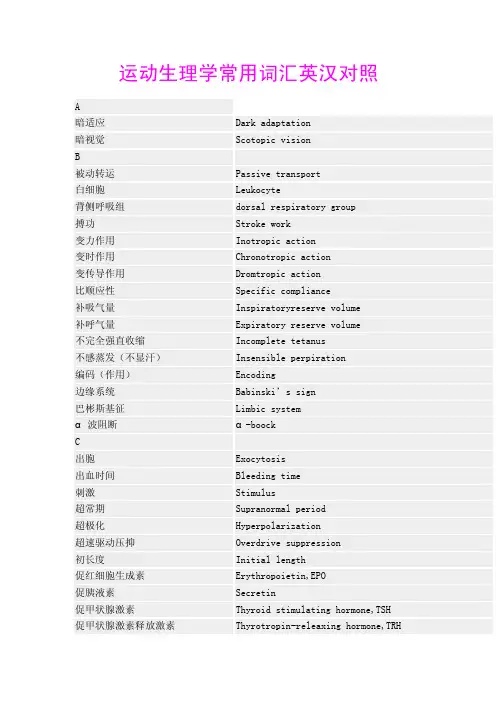
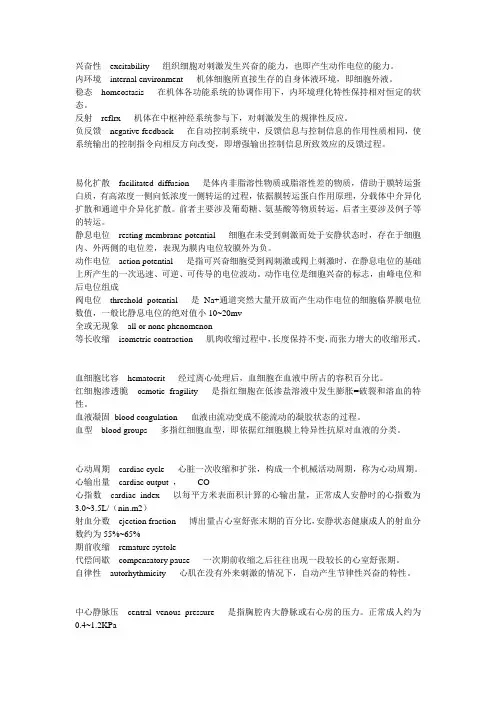
兴奋性excitability 组织细胞对刺激发生兴奋的能力,也即产生动作电位的能力。
内环境internal environment 机体细胞所直接生存的自身体液环境,即细胞外液。
稳态homeostasis 在机体各功能系统的协调作用下,内环境理化特性保持相对恒定的状态。
反射reflrx 机体在中枢神经系统参与下,对刺激发生的规律性反应。
负反馈negative feedback 在自动控制系统中,反馈信息与控制信息的作用性质相同,使系统输出的控制指令向相反方向改变,即增强输出控制信息所致效应的反馈过程。
易化扩散facilitated diffusion 是体内非脂溶性物质或脂溶性差的物质,借助于膜转运蛋白质,有高浓度一侧向低浓度一侧转运的过程,依据膜转运蛋白作用原理,分载体中介异化扩散和通道中介异化扩散。
前者主要涉及葡萄糖、氨基酸等物质转运,后者主要涉及例子等的转运。
静息电位resting membrane potential 细胞在未受到刺激而处于安静状态时,存在于细胞内、外两侧的电位差,表现为膜内电位较膜外为负。
动作电位action potential 是指可兴奋细胞受到阀刺激或阀上刺激时,在静息电位的基础上所产生的一次迅速、可逆、可传导的电位波动。
动作电位是细胞兴奋的标志,由峰电位和后电位组成阀电位threshold potential 是Na+通道突然大量开放而产生动作电位的细胞临界膜电位数值,一般比静息电位的绝对值小10~20mv全或无现象all or none phenomenon等长收缩isometric contraction 肌肉收缩过程中,长度保持不变,而张力增大的收缩形式。
血细胞比容hematocrit 经过离心处理后,血细胞在血液中所占的容积百分比。
红细胞渗透脆osmotic fragility 是指红细胞在低渗盐溶液中发生膨胀=破裂和溶血的特性。
血液凝固blood coagulation 血液由流动变成不能流动的凝胶状态的过程。

附录四生理学实验常用术语中英文对照1ą-波阻断alpha wave block氨基甲酸乙酯(脲酯,即乌拉坦) urethane 暗适应 dark adaptation安置 arrangeB白细胞 white blood cell (WBC)白细胞记数 numeration of leukocytes保护电极 protected electrode报告 report表面电极 surface electrode标准 standard波长 wavelength波宽 duration玻璃板 glass board玻璃分针 glass dissecting needle波形 wave form补呼气量 expiratory reserve volume补吸气量 inspiratory reserve volume不完全强直 incomplete tetanus不应期 refractory periodC材料material采血针 puncturing needle血型鉴定 blood typing蟾蜍toad肠肌 intestinal muscle潮气量 tidal volume抽血 draw blood穿刺 puncture传导速度 conduction velocity传出神经 efferent nerve传人神经 afferent nerve触发 trigger触发开关 trigger switch垂体后叶素 pituitrin刺激电极 stimulating electrode刺激伪迹 stimulating artifact促胰液素 secretin2大地,接地 ground大脑皮层 cerebral cortex大鼠rat代偿间歇 compensatory pause单极 monopolar单收缩 single twitch单相动作电位monophasic action potential胆盐 bile salt胆汁分泌 bile secretion导联 lead导线wire地,接地 earth (ground)滴管 dropper低血糖痉挛 hypoglycemic convulsion电磁标 signal magnet电刺激装置electrical stimulation apparatus电流 current电极 electrode电机械换能器electromechanical transducer电生理学 electrophysiology电压 voltage电压钳制术 voltage clamp technique电子刺激器 electron stimulator动脉插管 arterial cannula动脉夹 artery clip动脉套管 arterial cannula动作电位 action potential窦神经 sinus nerve对照 control多导电生理记录仪multipurpose polygraphE耳蜗微音器电位Cochlea microphonic potentialF乏极化电极 non-polarizable electrode放大enlarge放大器 amplifier3放电频率 firing frequency反射弧 reflex arc反射时 reflex time肺活量 vital capacity肺量计 spirometer肺内压 intrapulmonary pressure肺容量 pulmonary capacity肺通气 pulmonary ventilation腓总神经 popliteal nerve分贝 decibel (db)酚红,酚磺酞pernol red (phenolsulfonphthalein, vPSP) 缝合suture缝线suture辐辏,汇聚 convergence腹腔注射intraperitoneal injectionG肝素 heparin干扰 disturbance感应电刺激器 inductirium杠杆lever隔离 insulation, interference鸽子 dove狗 dog骨骼肌 skeletal muscle股神经 crural nerve光反射 light reflexH化学感受器 chemoreceptor红细胞red blood cell (RBC)红细胞比积 hematocrit红细胞沉降率erythrocyte sedimentation rate (ESR) 互感性光反射 consensual light reflex毁脑、脊髓的蟾蜍 pithed-toad呼吸运动 respiratory movementJ基础代谢率basal metabolic rate (BMR) 记滴器 drop recorder肌肉注射 intramuscular injection计时器 time recorder4记数板 counting slide记数池 counting chamber肌电图 electromyogram (EMG)脊椎动物 spinal animal肌动器 myograph肌紧张,肌张力 muscle tone脊髓反射 spinal reflex脊休克 spinal shock胫神经 tibial nerve静脉套管 venous cannula静脉注射venous injection, mainline静息电位 resting potential记录装置 recording apparatus剪刀 scissors监听器 audiomonitor交感神经 sympathetic nerve紧张期 tension period急性实验法 acute methodology减压神经放电discharge of depressor nerve减压反射 depressor reflex检压计 manometer局部麻醉 local anesthesiaK抗利尿激素 antidiuretic hormone (ADH)跨肺压 transpulmonary pressureL乐氏溶液 Locker's solution离体 in vitro离体蟾蜍心脏 isolated toad heart量血压take one's blood pressure硫喷妥钠 sodium pentothal氯醛糖chloralose颅骨钻 trephineM玛利氏气鼓 Marey's tambour麻醉剂 anesthetic agents麦克风,微音器 microphone脉率 pulse rate麦氏溶液 Magu’s solution盲点 blind spot5猫 cat每分钟通气量 minute ventilation volume 每分钟心输出量 minute cardiac output 描记气鼓 recording tambour前庭功能 vestibular function迷走神经 vagus nerveN脑电图 electroencephalogram (EEG)脑电图仪 electroencephalograph钠石灰 soda lime能量代谢 energy metabolism尿激酶 urokinase尿生成 urine formation凝固 coagulationP培养皿 culture dish运动皮质 motor cortex皮下注射 subcutaneous injection平滑肌 smooth muscle普通电极 common electrodeQ潜伏期 latent period强度—时间曲线 strength-duration curve 前置放大器 preamplifier气管插管 trachea cannula气管套管 tracheal cannula期前收缩 premature contraction期前兴奋 premature excitation切开 incision气胸 pneumothorax去大脑僵直 decerebrated rigidity去甲肾上腺素 noradrenaline (NA)躯体运动 somatic movement屈反射 flexion reflex全身麻醉 general anesthesia犬 dogR任内实验 Renne's test妊娠实验 pregnancy test任氏溶液 Renne's solution6人体绒毛膜促性腺激素human chorionic gonadotropin (HCG)S扫描 sweep搔抓反射 scratch reflex纱布 gauze神经冲动 nerve impulse神经肌单位 neuromuscular unit神经调节 nerve regulation肾上腺素能神经 adrenergic nerve生理溶液 physiological solution生理学实验 physiological experiments生理盐水 normal saline生物电 bioelectricity射血前期 pre-ejection period (PEP)示波器 oscilloscope, oscillograph时间肺活量 timed vital capacity时基 time base视力表 visual testing chart视力计 optometer视敏度,视力 visual acuity视网膜电图 electroretinogram (ERG)视野 visual field实验设计 experimental design手术刀 scalpel手术灯 operating lamp手术台 operating table输出 output输入端 input输液 fluid injection双相动作电位 biphasic action potential斯氏第一结扎 stanniu’s first ligature斯氏第二结扎 stanniu's second ligature水检压计 water manometer水银检压计mecury manometer顺应性 compliance速率rate速尿 furosemide缩瞳 muosisT台氏溶液 Tyrode's solution体温计 thermometer调节反射 accommodation reflex7听诊器 stethoscope同步,同时性 synchronism铜锌弓(双金属电极) bimetal electrode 图,曲线diagram兔 rabbit脱脂棉 adsorben cottonW蛙 frog蛙心夹 heart chip完全强直收缩 completetetanus魏伯实验 Weber's test胃肠运动 gastrointestinal movement微音器效应 microphonic effect戊巴比妥钠 sodium pentobarbital无创伤测定 noninvasive assessmentX显微镜 microscope小脑损伤 cerebellar injury小鼠 mouse效应 effect心电图 electrocardiogram (ECG)心电向量图 vectorcardiogram心肌 myocardium兴奋 excitation兴奋性 excitability纤维蛋白溶解 fibrinolysis胸内负压 intrathoracic negative pressure 血红蛋白 hemoglobin (Hb)血红蛋白的测定estimation of hemoglobin 血红蛋白计 hemoglobinometer血管钳 hemostat血浆 plasma血流 blood blow血清serum血压 blood pressure血压计 hemomanometer血液凝固 blood coagulation血细胞记数器 hemocytometer血型 blood groupY压力感受器 baroreceptor8延迟delay易化区 facilitatory area咬骨钳 bone forceps乙醚ether乙酰胆碱 acetylcholine (ACh)抑制 inhibition抑制区 inhibitory area阴极 cathode阴极射线示波器 cathoderay oscillograph音叉 tuning fork影响influence诱发电位 evoked potential运动单位 motor unit阈电位 threshold potential阈刺激 threshold stimulus阈上刺激 suprathreshold stimulus阈下刺激 subthreshold stimulus阈值 thresho1dZ在体 in vivo止血 stop bleeding止血钳 hemostatic forceps振幅 amplitude正规胰岛素 regular insulin主动脉神经 aortic nerve注射 inject装置 apparatus增益gain针形电极 point electrode注射器syringe注射器针头 syringe needle总电机械收缩期total electromechanical systole (TEMS)总和 summation阻断 cut-out阻尼,衰减 damping最大刺激 maximal stimulus最大收缩 maximal contraction最大通气量 maximal ventilation capicity坐骨神经-腓肠肌标本 sciatic-gastrocnemius preparatio9。
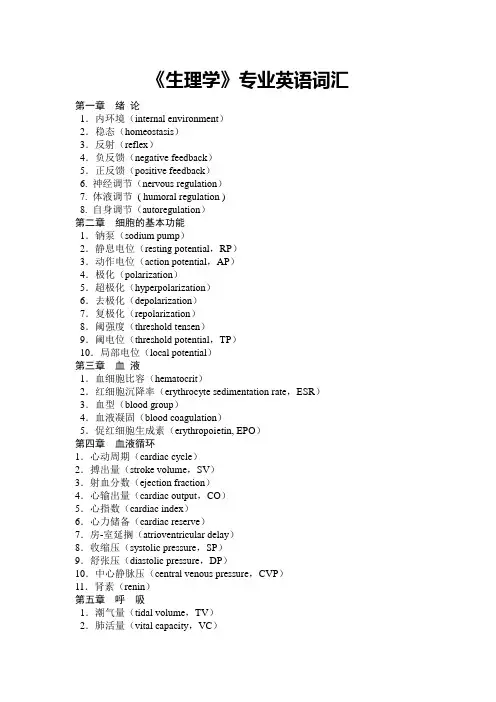
《生理学》专业英语词汇第一章绪论1.内环境(internal environment)2.稳态(homeostasis)3.反射(reflex)4.负反馈(negative feedback)5.正反馈(positive feedback)6. 神经调节(nervous regulation)7. 体液调节( humoral regulation )8. 自身调节(autoregulation)第二章细胞的基本功能1.钠泵(sodium pump)2.静息电位(resting potential,RP)3.动作电位(action potential,AP)4.极化(polarization)5.超极化(hyperpolarization)6.去极化(depolarization)7.复极化(repolarization)8.阈强度(threshold tensen)9.阈电位(threshold potential,TP)10.局部电位(local potential)第三章血液1.血细胞比容(hematocrit)2.红细胞沉降率(erythrocyte sedimentation rate,ESR)3.血型(blood group)4.血液凝固(blood coagulation)5.促红细胞生成素(erythropoietin, EPO)第四章血液循环1.心动周期(cardiac cycle)2.搏出量(stroke volume,SV)3.射血分数(ejection fraction)4.心输出量(cardiac output,CO)5.心指数(cardiac index)6.心力储备(cardiac reserve)7.房-室延搁(atrioventricular delay)8.收缩压(systolic pressure,SP)9.舒张压(diastolic pressure,DP)10.中心静脉压(central venous pressure,CVP)11.肾素(renin)第五章呼吸1.潮气量(tidal volume,TV)2.肺活量(vital capacity,VC)3.用力肺活量(forced vital capacity,FVC)4.解剖无效腔(anatomical dead space)5.肺泡通气量(alveolar ventilation)6.肺通气/血流比值(ventilation/perfusion ratio)7.肺表面活性物质pulmonary surfactant第六章消化和吸收1.消化(digestion)2.吸收(absorption)3.脑-肠肽(brain-gut peptide)4.胃排空(gastic emptying)5.容受性舒张(receptive relaxation)6. 胆盐的肠肝循环(enterohepatic circulation of bile salt)第八章尿的生成和排出1.肾小球滤过率(glomerular filtration rate,GFR)2.滤过分数(filtration fraction,FF)3.肾糖阈(renal thredhold for glucose)4.渗透性利尿(osmotic diuresis)5.球-管平衡(glomerulotubular balance)6.水利尿(water diuresis)7.肾血浆清除率(renal plasma clearance)第九章神经系统的功能1.(感受器的)换能作用(transducer function)2.明适应(light adaptation)3.暗适应(dark adaptation)4.兴奋性突触后电位(excitatory postsynaptic potential,EPSP)5.抑制性突触后电位(inhibitory postsynaptic potential,IPSP)6.牵涉痛(referred pain)7.脊休克(spinal shock)8.牵张反射(stretch reflex)9.肌紧张(muscle tonus)10.去大脑僵直(decerebrate rigidity)第十章内分泌1.(激素的)允许作用(permissive action)2.下丘脑调节肽(hypothalamic regulatory peptide,HRP)3.应激(stress)。
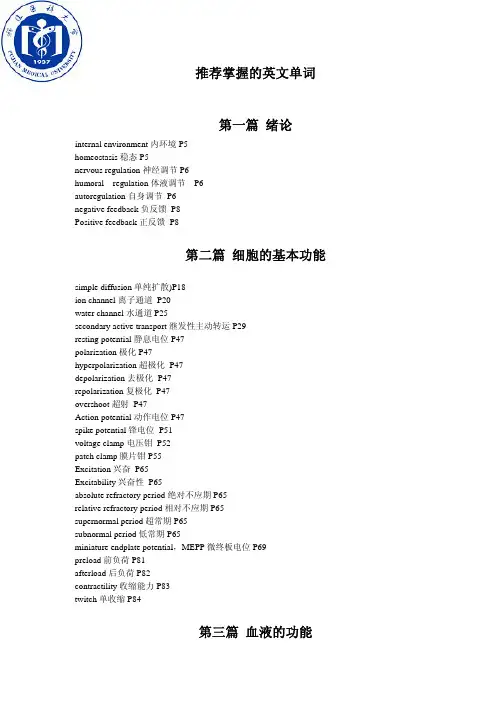
推荐掌握的英文单词第一篇绪论internal environment内环境P5homeostasis稳态P5nervous regulation神经调节P6humoral regulation体液调节P6autoregulation自身调节 P6negative feedback负反馈 P8Positive feedback正反馈 P8第二篇细胞的基本功能simple diffusion单纯扩散)P18ion channel离子通道 P20water channel水通道P25secondary active transport继发性主动转运P29resting potential静息电位P47polarization极化P47hyperpolarization超极化 P47depolarization去极化 P47repolarization复极化 P47overshoot超射 P47Action potential动作电位P47spike potential锋电位 P51voltage clamp电压钳 P52patch clamp膜片钳P55Excitation兴奋 P65Excitability兴奋性 P65absolute refractory period绝对不应期P65relative refractory period相对不应期P65supernormal period超常期P65subnormal period低常期P65miniature endplate potential,MEPP微终板电位P69preload前负荷P81afterload后负荷P82contractility收缩能力P83twitch单收缩P84第三篇血液的功能Erythrocyte Sedimentation Rate,ESR红细胞沉降率(血沉)P99 osmotic fragility渗透脆性 P99bleeding time出血时间P111Blood group血型P112blood coagulation血液凝固 P118clotting factor凝血因子 P118第四篇血液循环第九章心脏的生物电活动pump function 起搏功能autorhythmicity 自动节律性pacemaking function 起搏功能maximum diastolic potential, MDP 最大舒张电位maximum repolarization potential 最大复极电位fast response action potential快反应动作电位fast response cell 快反应细胞slow response action potential慢反应动作电位slow response cell 慢反应细胞sodium-calcium exchange 钠-钙交换electrocardiogram, ECG 心电图action potential duration,APD 动作电位时程amplitude of action potential, APA 动作电位幅值transient outward current, I to瞬时性外向离子流plateau phase 平台期long lasting calcium current,I Ca-Leffective refractory period, ERP 有效不应期premature systole 期前收缩extrasystole 期外收缩compensatory pause 代偿性间歇cardiac arrthythmia 心律失常sinus rhythm 窦性心律dominant pacemaker 主导起搏点latent pacemaker 潜在起搏点ectopic pacemaker 异位起搏点capture 抢先占领overdrive suppression 超速驱动压抑positive chronotropic action 正性变时作用negative chronotropic action 负性变时作用preferential pathway 优势传导通路functional syncytium 功能合胞体atrioventricular delay 房室延搁positive dromotropic action 正性变传导作用negative dromotropic action 负性变传导作用P-wave P波P-R interval P-R间期P-R segment P-R段QRS complex QFS波群S-T segment S-T段第十章心脏的泵血功能contractility 收缩性positive inotropic action 正性变力作用negative inotropic action 负性变力作用calcium-induced calcium release, CICR 钙触发钙释放calcium transient 钙瞬变atrial natriuretic peptide, ANP 心房钠尿肽endothelin 内皮素angiotension II 血管紧张素cardiac cycle 心动周期systole 收缩期diastole 舒张期pump cycle 泵周期ventricular systole 心室收缩期isovolumic contraction phase 等容收缩期injection phase 射血期rapid injection phase 快速射血期reduced injection phase 减慢射血期isovolumic relaxation phase等容舒张期rapid filling phase 快速充盈期reduced filling phase减慢充盈期priming pupm 初级泵heart sound 心音stroke volume 搏出量ejection fraction, EF 射血分数cardiac output,CO 心输出量cardiac index 心指数stroke work 搏功cardiac reserve 心力储备heterometric autoregulation 异长自身调节ventricular function curve 心室功能曲线homometric regulation 等长第十一章血管生理Windkessel vessel 弹性储器血管distribution vessel 分配血管precapillary resistance vessel 毛细血管前阻力血管precapillary sphincter 毛细血管前括约肌exchange vessel 交换血管postcapillary resistance vessel 毛细血管后阻力血管capacitance vessel 容量血管shunt vessel 短路血管arteriovenous shunt 动-静脉短路renin 肾素angiotensin 血管紧张素resistance of blood flow 血流阻力blood viscosity 血液粘滞度blood pressure 血压arterial blood pressure 动脉血压mean circulatory filling pressure 循环系统平均充盈压peripheral resistance 外周阻力systolic pressure 收缩压diastolic prssure 舒张压pulse pressure 脉压mean arterial pressure 平均动脉压central venous pressure 中心静脉压peripheral venous 外周静脉压venous return 静脉回心血量microcirculation 微循环ateriole 微动脉metarteriole 后微动脉throughfare 直捷通路effective filtration pressure 有效滤过压cardiac vagal tone 心迷走紧张cardiac sympathetic tone 心交感紧张vasoconstrictor nerve 缩血管神经vasodilator nerve 舒血管神经sympathetic vasoconstrictor tone交感缩血管紧张sympathetic vasoconstrictor center交感缩血管中枢cardiac sympathetic center 心交感中枢cardiac vagus center 心迷走中枢cardiaovascular reflex 心血管反射arterial baroreceptor reflex 压力感受性反射depressor reflex降压反射carotid sinus 颈动脉窦aortic arch 主动脉弓carotid sinus nerve 颈动脉窦神经chemoreceptor reflex 化学感受器反射carotid body 颈动脉体aortic body 主动脉体renin-angiotensin system, RAS 肾素-血管紧张素系统angiotensin-converting enzyme,ACE 血管紧张素转换酶adrenaline, epinephrine 肾上腺素noradrenaline, norepinephrine 去甲肾上腺素vasopressin 血管升压素nitric oxide, NO一氧化氮renal-body system 肾体液控制系统第十三章 器官循环coronary circulation 冠脉循环adnosine 腺苷第五篇 呼吸第十四章 肺通气respiration 呼吸external Respiration外呼吸internal respiration 内呼吸pulmonary ventilation 肺通气intrapulmonary pressure 肺内压inspiration 吸气expiration 呼气artificial respiration 人工呼吸respiratory movement 呼吸运动abdominal breathing 腹式呼吸thoracic breathing 胸式呼吸eupnea 平静呼吸forced breathing 用力呼吸intrapleural pressure 胸膜腔内压pneumothorax 气胸lung compliance 肺顺应性pulmonary surfactant 肺表面活性物质dipalmitoyl phosphatidyl choline, DPPC 二棕榈酰卵磷脂inelastic resistance 非弹性阻力restrictive hypoventilation 限制性通气不足obstructive hypoventilation 阻塞性通气不足pulmonary volume 肺容积tidal volume, TV 潮气量inspiratory reserve volume, IRV补吸气量expiratory reserve,ERV补呼气量residual volume,RV 残气量functional residual capacity, FRC 功能残气量vital capacity,VC 肺活量forced expiratory volume, FEV用力呼气量total lung capacity 肺总量pulmonary ventilation 肺通气量maximal voluntary ventilation 最大随意通气量anatomical dead space解剖无效腔alveolar dead space 肺泡无效腔physiological dead space 生理无效腔alveolar ventilation肺泡通气量第十五章 肺换气和组织换气respiratory membrane 呼吸膜ventilation/perfusion ratio通气-血流比值第十六章 氧和二氧化碳在血液中的运输oxyhemoglobin 氧合血红蛋白deoxyhemoglobin 去氧血红蛋白oxygen capacity of Hb Hb的氧容量oxygen content of Hb Hb的氧含量oxygen saturation of Hb Hb的氧饱和度oxygen dissociation curve氧解离曲线Bohr effect 波尔效应carbaminohemoglobin 氨基甲酰血红蛋白第十七章 呼吸运动的调节respiratory center 呼吸中枢apneusis 长吸式呼吸pneumotaxic center呼吸调整中枢inspiratory neuron 吸气神经元expiratory neuron 呼气神经元respiratory rhythm呼吸节律peripheral chemoreceptor 外周化学感受器central chemoreceptor 外周化学感受器pulmonary stretch reflex 肺牵张反射第六篇 消化slow wave potential慢波电位basic electrical rhythm基本电节律gastrointestinal hormone胃肠激素mucus-bicarbonate barrier粘液-碳酸氢盐屏障enterohepatic circulation of bile salt胆盐的肠肝循环peristalsis蠕动low esophageal sphincter食管下括约肌entero-gastric reflex肠-胃反射segmentation contraction分节运动digestion消化absorption吸收第七篇 能量代谢与体温thermal equivalent of food食物的热价caloric value of food食物的卡价thermal equivalent of oxygen食物的氧热价respiratory quotient呼吸商specific dynamic action食物的特殊动力效应basal metabolism基础代谢body temperature体温core temperature深部温度shell temperature表层温度circadian rhythm日节律biorhythm生物节律radiation)辐射conduction传导convection对流insensible evaporation不感蒸发sensible evaporation可感蒸发thermal sweating温热性发汗mental sweating精神性发汗gustatory sweating味觉性发汗autonomic thermoregulation自主性体温调节behavioral thermoregulation行为性体温调节set point调定点第八篇 尿的生成与排出autoregulation of renal blood flow肾血流量的自身调节glomerular filtration rate肾小球滤过率filtration fraction滤过分数effective filtration pressure有效滤过压renal glucose threshold肾糖阈secretion分泌clearance清楚率tubuloglomerular feedback管球反馈glomerulotubular balance球管平衡osmotic diuresis渗透性利尿renorenal reflex肾-肾反射第九篇 神经系统receptor感受器adequate stimulus适宜刺激receptor potential感受器电位generator potential发生器电位coding编码作用adaptation适应现象reduced eye简化眼visual acuity视敏度visual accommodation眼的调节near point of vision近点myopia近视hyperopia远视astimatism散光nyctalopia夜盲症dark adaptation暗适应light adaptation明适应visual field视野hearing threshold听阈air conduction气导bone conduction骨导microphonic potential蜗微音器电位nystagmus眼震颤neuron神经元nerve impulse神经冲动axoplasmic transport轴浆运输postsynaptic potential突触后电位EPSP兴奋性突触后电位IPSP抑制性突触后电位postsynaptic inhibition突触后抑制presynaptic inhibition突触前抑制presynaptic facilitation突触前易化synaptic delay突触延搁electric synaptic transmission电突触传递 neurotransmitter神经递质cholinergic fiber胆碱能纤维adrenergic fiber肾上腺素能纤维specific projection system特异性投射系统non- specific projection system非特异性投射系统 evoked cortical potential皮层诱发电位()、 referred pain牵涉痛muscle tonus肌紧张tendon reflex腱反射spinal shock脊休克stretch reflex牵张反射decerebrate rigidity去大脑僵直conditioned reflex条件反射unconditioned reflex非条件反射first signal system第一信号系统second signal system第二信号系统 electroencephalograme,EEG脑电图α-blockα波阻断slow wave sleep慢波睡眠第十篇 内分泌内分泌endocrine激素hormone神经内分泌neuroendocrine内分泌系统endocrine system胺类激素amine hormone多肽和蛋白质类激素polypeptide and protein hormone类固醇激素steroid hormone下丘脑-垂体-靶腺轴hypothalamus-adenohypophysis-target gland axis 下丘脑-垂体-甲状腺轴hypothalamus-adenohypophysis-thyroid axis 下丘脑-垂体-肾上腺皮质腺轴hypothalamus-adrenocortical gland axis 下丘脑-垂体-性腺轴hypothalamus-adenohypophysis-gonadal axis生长激素释放激素growth hormone releasing hormone生长抑素somatostatin或growth hormone release inhibiting hormone 促甲状腺激素释放激素thyrotropin releasing hormone促肾上腺皮质激素释放激素corticotropin-releasing hormone促性腺激素释放激素gonadotropin-releasing hormone生长激素growth hormone促甲状腺激素thyroid-stimulating hormone促肾上腺皮质激素adrenocortical hormone卵泡刺激素follicle stimulating hormone黄体生成素luteinizing hormone胰岛素样生长因子insulin-like growth factor应激反应stress reaction催乳素prolactin缩宫素oxytocin甲状腺激素thyroid hormone胰岛素insulin糖皮质激素glucocorticoid允许作用permissive action应急反应emergency reaction雄激素androgen排卵ovulation雌激素female sex hormone孕激素pregnancy hormone。
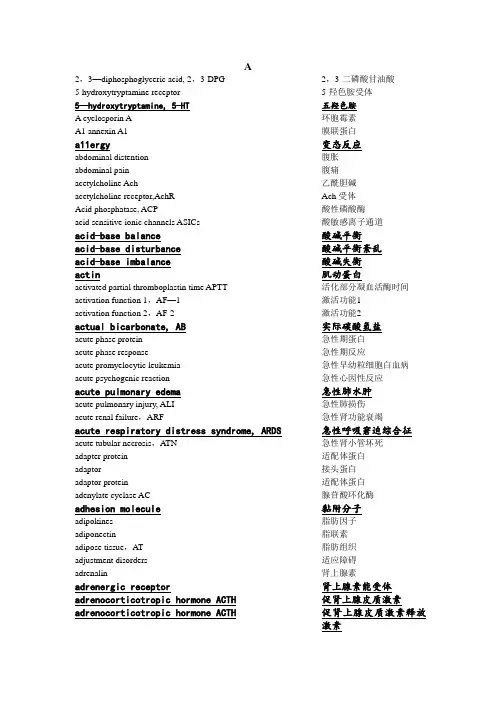
A2,3—diphosphoglyceric acid, 2,3-DPG 2,3-二磷酸甘油酸5-hydroxytryptamine receptor 5-羟色胺受体5—hydroxytryptamine, 5-HT 五羟色胺A cyclosporin A 环胞霉素A1 annexin A1 膜联蛋白a11ergy 变态反应abdominal distention 腹胀abdominal pain 腹痛acetylcholine Ach 乙酰胆碱acetylcholine receptor,AchR Ach受体Acid phosphatase, ACP 酸性磷酸酶acid sensitive ionic channels ASICs 酸敏感离子通道acid-base balance 酸碱平衡acid-base disturbance 酸碱平衡紊乱acid-base imbalance 酸碱失衡actin 肌动蛋白activated partial thromboplastin time APTT 活化部分凝血活酶时间activation function 1,AF—1 激活功能1activation function 2,AF-2 激活功能2actual bicarbonate, AB 实际碳酸氢盐acute phase protein 急性期蛋白acute phase response 急性期反应acute promyelocytic leukemia 急性早幼粒细胞白血病acute psychogenic reaction 急性心因性反应acute pulmonary edema 急性肺水肿acute pulmonary injury, ALI 急性肺损伤acute renal failure,ARF 急性肾功能衰竭acute respiratory distress syndrome, ARDS 急性呼吸窘迫综合征acute tubular necrosis,A TN 急性肾小管坏死adapter protein 适配体蛋白adaptor 接头蛋白adaptor protein 适配体蛋白adenylate cyclase AC 腺苷酸环化酶adhesion molecule 黏附分子adipokines 脂肪因子adiponectin 脂联素adipose tissue,AT 脂肪组织adjustment disorders 适应障碍adrenalin 肾上腺素adrenergic receptor 肾上腺素能受体adrenocorticotropic hormone ACTH 促肾上腺皮质激素adrenocorticotropic hormone ACTH 促肾上腺皮质激素释放激素adriamycin 阿霉素advanced glycosylation end products, AGE 38 39 高级糖基化终产物aflatoxin 黄曲霉毒素after depolarization 后除极aging 老化agonosia 失认aheolar ventilation 肺泡通气量alarm stage 警觉期aldosterone 醛固酮a-L—fucosidase,AFU a-L岩藻糖苷酶alignment of the chromosomes 染色质联会alkylating agents 烷化剂allelic heterogeneity 等位异质性allelic loss 等位基因丢失alpha—fetoprotein,AFP 甲胎蛋白alternative pathway 替代途径alternative splicing 选择性剪接alternative splicing,AS 选择性剪接alveolar PCO2, PACO2 肺泡气二氧化碳分压alveolar PO2,PAO2 肺泡气氧分压Alzheimer disease, AD 阿尔茨海默病a—Melanocyte stimulating hormone, a-MSH 黑素细胞刺激素American College of Cardiology,ACC 美国心脏病学会American Heart Association,AHA 美国心脏协会ammonia 氨中毒amplification of signal 信号放大amygdala 杏仁核amyloid precursor protein,ARP 淀粉样蛋白前体anaphase 后期anaphylactic shock 过敏性休克anaphylactoid purpura 过敏性紫癜Anaplasma phagocytophilum 嗜吞噬无形体anasarca 全身性水肿anatomic shunt 解剖分流angiogenin 基因扩增angiotensin Ⅰ,Ang Ⅰ血管紧张素Ⅰangiotensin Ⅱ,AngⅡ血管紧张素Ⅱangiotensin-converting enzyme, ACE 血管紧张素转化酶angiotension converting enzyme inhibitor,ACEI 血管紧张素转换酶抑制剂anion gap,AG 阴离子间隙ankyrin 锚蛋白annexin 2 膜联蛋白2annexin-1 膜联蛋白—1anorexia 食欲不振anterior cingule cortex ACC 大脑前扣带皮质antidiuretic hormone,ADH 抗利尿激素antimetabolite 血管生长素antiostain 抗代谢药物antisense 反义antithrombin III AT III 抗凝血酶IIIanuia 无尿aphasia 失语aplastic anemia 再生障碍性贫血apolipoprotein A1 血管抑制素apoptosis 凋亡apoptosis 细胞凋亡apoptosis inducing factor,AIF 凋亡诱导因子apoptosome 凋亡复合体apoptotic bodies 凋亡小体apoptotic effector 凋亡效应因子apoptotic lesion 凋亡性损伤apoptotic protease activating factor,Apaf 凋亡蛋白酶激活因子apraxia 失用aquaporin,AQP 水通道arachidonic acid AA 花生四烯酸aralkylating agents 载脂蛋白A1ARAS 上行网状激动系统arcuate nucleus,ARC 弓状核Arg-Gly-Asp,GRD 芳烷化剂arginine vasopressin,A VP 精氨酸加压素arginine,R 精氨酸aromatic amino acids,AAA 芳香族氨基酸arrhythmia 心律失常arylhydroxylamines 精-甘-天冬氨酸asbestos 芳基异羟肟胺类ascending reticular activating system ARAS 脑干上行网状激动系统ascending reticular inhibitory system ARIS 上行网状抑制系统asymbolia for pain 疼痛说示不能综合征asymmetric cell division 细胞的不对称分裂ata 石棉ataxia and rad3 related,ATR 共济失调毛细血管扩张症Rad3相关蛋白Ataxia telangiectasia,A T 共济失调性毛细血管扩张症ataxia-telangiectasia,AT 毛细血管扩张性共济失调症突变基因ataxia—telangiectasia—mutated,A TM 毛细血管扩张性共济失调突变蛋白atherosclerosis,AS 动脉粥样硬化athogenesis 发病学ATLL T 细胞白血病淋巴瘤ATP binding pocket ATP结合口袋ATP receptor ATP受体atrial natriuretic peptide ANP 心房利尿钠肽autocrine motility factor,AMF 自分泌运动因子autoimmune disease 自身免疫性疾病automatic external defibrillator,AED 自动体外除颤器automatic impulse 自主性激动autophagic cell death 自噬性细胞死亡autophagin 自噬素autophagolysosome 自噬溶酶体autophagosome,AP 自噬体autophagy 细胞自噬autophagy 自噬autophagy 自噬性程序性细胞死亡autophagy-related proteins,Atg 细胞自噬相关蛋白autophosphorylation 自主磷酸化azotemia 氮质血症α—lactalbumin α—乳白蛋白BB1 cyclin B1 细胞周期蛋白bacterial translocation 细菌移位BaP 苯并芘base excess,BE 碱剩余base excision repair,BER 碱基切除修复baterial endotoxin 细菌内毒素Bax—interacting factor 1,BIF-1 Bax作用因子1B—cell lymphoma 2,Bcl-2 B细胞淋巴瘤2Bcl—2 homology,BH Bcl—2同源结构域beme oxygenase 血红素加氧酶benign tumor 良性肿瘤benzediazepine,BZ 苯二氮卓Beta-amyloid,Aββ—淀粉样蛋白biallelic 二等位基因bi—allelie marker 双等位标记big MAP kinase,BMK1 大丝裂原活化蛋白激酶bilinogen enterohepatic circulation 胆素原的肠肝循环bilirubin 胆红素bilirubin encephalopathy 胆红素性脑病biliverdin reductase 胆绿素还原酶biofeedback therapy 生物反馈治疗bioinformatics 生物信息学blebbing 水泡化blood urea nitrogen,BUN 血浆尿素氮bone marrow hematopoietic stem cells 骨髓造血干细胞bradykinin BK 缓激肽brain derived neurotrophic factor,BDNF 脑源神经营养因子brain stem 脑干brain—derived neurotrophic factor BDNF 脑源性神经营养因子branched-chain amino acids,BCAA 支链氨基酸breakage-fusion-brige,BFB 断裂—融合-桥breast cancer susceptibility gene C terminus,BRCT 乳腺癌易感基因羧基末端结构域brown adipo 棕色脂肪组织Brugada Syndrome Brugada综合征buffer base, BB 缓冲碱Burkholderia pseudomallei 类鼻疽伯克霍尔德菌burn shoch 烧伤性休克butyrolactone 丁内酯bystander cell 旁观者细胞β2—Microglobulin,β2Mβ2—微球蛋白β-amyloid precursor protein β-淀粉样前体蛋白β—amyloid protein β—淀粉样蛋白β—endorphin β—内啡肽β—lactams β—内酰胺类CC cytochrome C,Cyto-C 细胞色素C1—esterase inhibitor C1酯酶抑制物Ca2+ ionophore Ca2+离子载体cadherin 钙离子依赖的细胞黏附素cadherins 钙粘蛋白calcitonin ,CT 降钙素calcitonin gene related protein CGRP 降钙素基因相关蛋白calcium dyshomeostasis 钙稳态失衡calcium leak Ca2+泄漏calcium overload 钙超载calcium paradox 钙反常calcium transient Ca2+瞬变calmodulin,CaM 钙调蛋白calmodulin-dependent kinase II,CaMK II 钙调蛋白依赖性激酶II calmodulin-dependent kinase,CaMK 钙调蛋白依赖性激酶cancer 癌症cancer stem cells,CSC 肿瘤干细胞capping protein 加帽蛋白carbon dioxide narcosis 二氧化碳麻醉carbon monoxide,CO 一氧化碳carbonic anhydrase, CA 碳酸酐酶carboxyhemoglobin, HbCO 碳氧血红蛋白carcinoembryonic antigen,CEA 癌胚抗原carcinogen 致癌物cardiac asthma 心源性哮喘cardiac edema 心性水肿cardiac index,CI 心脏指数cardiac insufficiency 心功能不全cardiac output,CO 心输出量cardiac resynchronization therapy,CRT 心脏再同步治疗cardiogenic shock 心源性休克carnitine palmitoyl transferase-1,CPT-1 肉碱脂酰转移酶-1 caspase 半胱天冬酶caspase—like apoptosis regulatory protein,CLARP 半胱天冬酶样凋亡调节蛋白Caspase-recruitment domain,CARD 凋亡蛋白酶募集结构域catabolic process 分解代谢过程catecholamine 儿茶酚胺catecholamine,CA 儿茶酚胺Catypical protein kinase C,aPKC 非典型性蛋白激酶CDK inhibitor,CKI CDK抑制因子CDK-activating kinase,CAK CDK活化激酶CEA 癌胚抗原cell adhesion molecule,CAM 细胞粘附分子cell cycle 细胞周期Cell Damage 细胞损伤cell differentiation 细胞分化cell division 细胞分裂cell division cycle 2,CDC2 细胞分裂周期2cell pathology 细胞病理学cell proliferation 细胞增殖cell signaling 细胞信号传递cell stress 细胞应激cellular hydration 细胞水合cellular oncogene 细胞癌基因central nervous system CNS 中枢神经系统central pain 中枢性疼痛central venous pressure,CVP 中心静脉压centrosome 中心体cerebral cortex 大脑皮层chaperokine 伴侣因子chaperon mediated autophagy,CMA 分子伴侣介导的自噬checkpoint 检测点chemokine 趋化因子chemokine receptors 趋化因子受体chemoprevention 化学预防cholecystokinin CCK 胆囊收缩素choline acetyl transferase ChAT 胆碱乙酰基转移酶chondroitin sulfate 硫酸软骨素chromatin body 染色质小体chromosomal aberration 染色体畸变chromosomal instability,CIN 染色体不稳定chromosome instability 染色体不稳定性chronic bronchitis 慢性支气管炎chronic inflammationsyndrome 慢性炎症综合征chronic obstructive pulmonary disease,COPD 慢性阻塞性肺疾病chronic renal failure,CRF 慢性肾功能衰竭ciliary neurotrophic factor CNTF 睫状神经营养因子ciliary neurotrophic factor, CNTF 睫状神经营养因子circulatory hypoxia 循环性缺氧cirrhosis of liver 肝硬化cis-acting element 顺式作用元件cis-acting element 顺式作用元件cis—regulatory module 顺式调节模块c—Jun N terminal kinase,JNK c—Jun N端蛋白激酶class I PI3K protein I类PI3K蛋白clot 血凝块cluster 集簇coactivator 共激活因子coagulation 凝血Coding—region SNPs,cSNPs 基因编码区SNPs cognitive appraisal 认知评价cognitive disorder,cognitive handicap 认知障碍cold inducible RNA—binding protein 寒冷诱导的RNA结合蛋白cold sensitive neuron 冷敏神经元cold shock 冷休克cold shock protein 冷休克蛋白cold shock response 冷休克反应cold stress 冷应激collagen 胶原collagenases 胶原酶coma 昏迷代偿性抗炎反应综合征compensatory anti-inflammatory responsesyndrome,CARScompensatory stage of shock 休克代偿期complement,C 补体complete recovery 完全康复complex multisite variants 复合性多位点变异concentric hypertrophy 向心性肥大confusion 意识模糊congestive hypoxia 淤血性缺氧conjugated bilirubin 结合胆红conscious disturbance 意识障碍consciousness 意识constipation 便秘constitutive expression 基础表达content of consciousness 意识内容contraction alkalosis 浓缩性碱中毒copy number variant, CNV . 拷贝数目变异copy number variation,CNVs 拷贝数变异Core temperature 核心温度co-receptor 辅受体分子corepressor 共遏蛋白cornu dorsale medullae spinalis 脊髓背角cornu posterius medullae spinalis 脊髓后角corticostriatal loop 皮层-纹状体环路corticotrophin releasing hormone, CRH 促肾上腺皮质激素释放激素Coxiella burnetii 贝氏柯克斯体Coxsackie virus 柯萨奇病毒CpG island methylator phenotype,CIMP CpG岛的甲基化表型CpG islands CpG岛c—reactive protein C-反应蛋白C-reactive protein,CRP C—反应蛋白cross-bridge 横桥cross—talk 交叉对话cryotherapy 冷冻疗法cSNP synonymous cSNP 同义cSNPs non—synonymous cSNP 非同义C-terminal domain,CTD C-端结构域cyanosis 发绀cyclic adenosine monophosphate,cAMP 环磷酸腺苷cyclic GMP,cGMP 环磷酸鸟苷cyclin 周期素cyclin—dependent kinase complex 周期素依赖性激酶复合物cyclin-dependent kinase,CDK 依赖周期素激酶cyclin-dependent protein kinase 4,CDK4 细胞周期素依赖性激酶4S cyclooxygenase 环加氧酶cyclooxygenase COX 环氧合酶cycloxygenase,COX 环加氧酶cysteine-containing aspartate-specific protease,凋亡蛋白酶Caspasecystic fibrosis 纤维囊性变囊性纤维化转膜传导调节因子cystic fibrosis transmembrane conductanceregulator,CFTRcytochrome P450 monooxygenase 细胞色素P450单氧合酶cytoglobin,CGb 胞红蛋白cytokine 细胞因子cytokine cascade 细胞因子级联反应cytoplasmic death 细胞浆性细胞死亡cytoplasmic receptor 胞浆受体cytoplasm-to-vacuole targeting pathway,CVT 囊泡靶向通路γ-aminobutyric acid ,GABA γ-氨基丁酸γ—aminobutyric acid A receptor,GABAR γ-氨基丁酸受体Ddanger signal 危险信号data mining 信息分析D—dimer D—二聚体de novo synthesis 重新合成dead space like ventilation 死腔样通气dead space volume, VD 生理性死腔量death domain,DD 死亡结构域death effector domain,DED 死亡效应结构域death—inducing signaling complex,DISC 死亡诱导信号复合体decompensatory stage of shock 休克失代偿期decorticated state 去大脑皮质状态decoy protein 陷阱蛋白defensin 防御素defervesence peroid 体温下降期degradation 降解degradative autophagic vacuole,A Vd 降解性细胞自噬体delayed afterdepolarization,DAD 延迟后除极delayed psychogenic reaction 延迟性心因性反应delayed repolarization 延迟复极deletion 缺失deletions 缺失delirium 瞻妄状态denaturation 变性dermatan sulfate 硫酸皮肤素desmin,DM 肌间线蛋白Di George综合征先天性胸腺发育不全diabetes mellitus 糖尿病diabetes,DM 糖尿病diabetic nephropathy, DN 糖尿病肾病diacylglycerol DAG 甘油二酯diacylglycerol,DAG 甘油二酯diarrhea 腹泻diastolic heart failure 舒张性心力衰竭differential expression 差异表达differentiated cell 分化细胞diffusion impairment 弥散障碍dimer 二聚体direct—acting carcinogen 直接作用致癌物disase—modifying genes 疾病修饰基因disease 疾病disease Gene Network,DGN 疾病基因网络disease—associated gene 相关基因disease—Disease Gene Network 疾病与疾病基因网络disorder of absorption 吸收不良disorder of digestion 消化障碍disseminated intravascular coagulation DIC 弥散性血管内凝血distress 劣性应激DMBA 二甲基苯并蒽DNA damage checkpoint DNA损伤检测点DNA fragmentation DNA的片段化DNA methyltransferase,DNMT DNA甲基转移酶DNA protein kinase,DNA-PK DNA蛋白激酶DNA repair gene DNA修复基因DNA—binding domain,DBD DNA结合结构域DNA—dependent protein kinase 依赖性蛋白激酶domain 结构域dominant negative mutation 显性负突变dopamine, DA 多巴胺double acid—base disturbance 二重酸碱平衡紊乱double FYVE domain-containing protein 1,DFCP1 双FYVE结构域蛋白1 DSB 双链断裂duplications 重复Dynamic Electrocardiography,DCG 动态心电图dynamic mutation 动态突变dynorphin DYN 强啡肽dysfunction of gastrointestinal tract 胃肠道功能障碍:dysoxidative hypoxia 氧利用障碍性缺氧dyspnea 呼吸困难dyspnea on exertion 劳力性呼吸困难Eearly afterdepolarization,EAD 早期后除极eccentric hypertrophy 离心性肥大edema 水肿edema 水肿effector 执行者EF-hand EF手ejection fraction,EF 射血分数elastin 弹性蛋白elastin 弹性蛋白embryonic lineage 胚细胞系emergence reaction 紧急反应endocytotic pathway 内吞途径endogenous pyrogen,EP 内生致热原endoplasmic reticulum stress 内质网应激endoplasmic reticulum stress,ER Stress 内质网应激endoplasmic reticulum,ER 内质网endosome 内质体endostain 内抑素endothelial cell,EC 内皮细胞endothelial nitric oxide synthase,eNOS 内皮一氧化氮合成酶endothelin,ET—1 内皮素-1内皮细胞—白细胞粘附分子—1 endothelium leukocyte adhesion molecule-1ELAM-1endotoxic shock 内毒素休克endotoxin translocation 内毒素移位endotoxin,ET 内毒素end-stage renal disease,ESRD 终末期肾病engorgement of neck vein 颈静脉怒张enhancer 增强子enkephalin ENK 脑腓肽enterogenous cyanosis 肠源性紫绀environment determinants 环境决定子epidermal growth factor receptor,EGFR 表皮生长因子受体epidermal growth factor,EGF 表皮生长因子epigenetic modification 表观修饰epigenetic variation :表观遗传变异Epigenetics 表观遗传学epinephrine, E 肾上腺素EPO receptor,EPOR 促红细胞生成素受体equal pressure point 等压点ER stress response element 内质网应激反应元件ER—Golgi intermediate compartment,ERGIC 内质网-高尔基氏器中间体erythropoietin, EPO 促红细胞生成素erythropoietin,EPO 促红细胞生成素erythropoitin, EPO 促红细胞生成素esterified bilirubin酯型胆红素etiocholanolone 本胆烷醇酮euglobulin lysis time ELT 优球蛋白溶解时间eustress 良性应激euthanasia 安乐死evidence-based medicine EBM 循证医学excision repair 切除修复execution of apoptosis 凋亡执行execution of death 执行凋亡exhaustion stage 衰竭期exotoxins 外毒素experimental pathology 实验病理学experimental physiology 实验生理学expiratory dyspnea 呼气性呼吸困难extra-cellular domain 细胞外结构域extracellular fluid ECF 细胞外液extracellular heat shock protein 细胞外热休克蛋白extracellular matrix, ECM 细胞外基质extracellular signal?regulated kinase,ERK 细胞外信号调节激酶extrinsic inducer 外源性诱导因素exudate 渗出液FFADD-like interleukin—1β—converting enzyme,FADD样白介素-1β转换酶FLICEfalse neurotransmitter 假性神经递质familial erythrocytosis 家族性红细胞增多症familial polyposis coli,FPC 家族性结肠息肉病farnesoid X receptor,FXR 法呢醇X受体Fas—associated death domain,FADD Fas相关联的死亡结构域Fas-associated death domain,FADD Fas相关死亡结构域fast excitatory post—synaptic potential 快兴奋性突触后电位fate determinant,FD 命运决定子fatty streak 脂纹febrile ceiling 热限feed-back 反馈fervescence period 体温上升期fetal antigen 胚胎性抗原fever 发热fibrin / fibrinogen degradation product FDP/FgDP 纤维蛋白原降解产物fibrin Fbn 纤维蛋白fibrin monomer FM 纤维蛋白单体fibrinogen and fibrin degradation products, FDPs 纤维蛋白原降解产物Fibrinogen Fbg 纤维蛋白原fibroblast growth factor,FGF 成纤维细胞生长因子fibroblast growth factor,FGF 成纤维细胞生长因子fibronectin 纤维连接蛋白fibronectin,FN 纤连蛋白fibronectin,FN 纤维连接蛋白fight or flight 格斗或逃避filtration fraction FF 肾小球滤过分数fixed acid 固定酸FLICE—inhibitory protein,FLIP FLICE抑制蛋白foam cell 泡沫细胞focal adhesion linase,FAK 粘着斑激酶focal brain disorder 局灶性脑功能障碍focal—adhesion kinase,FAK 粘附斑激酶folding 折叠fork stalling and template switching,FoSTeS 复制叉停滞和模板转换fragile site 脆性位点Fragile site 脆性位点fragile site 染色体脆性位点frameshift mutation 移码突变frank edema 显性水肿free fatty acid;free fatty acids,FFA 游离脂肪酸free radical 自由基frontal lobe 额叶fully differentiated 完全分化functional dead space volume,VDf 功能性死腔量functional hepatorenal syndrome 功能性肝肾综合征functional renal failure 功能性肾衰functional shunt 功能性分流fundamental mechanism 基本机制GG endonuclease G,EndoG 核酸内切酶gastrointestinal motility 胃肠动力Gelatin 明胶酶gene deserts 基因沙漠区gene expression 基因表达gene expression regulation 基因表达调控gene knock out 基因敲除gene knock—out 基因剔除gene mutation 基因突变gene rearrangement 基因重排gene regulatory network 基因调控网络gene target 基因打靶general adaptation syndrome 全身适应综合征general Shwartzman reaction GSR 全身性Shwartzman反应genetic 遗传学genetic heterogeneity 遗传异质性Genetic polymorphism 遗传多态性genome 基因组genomic imprinted gene 基因组印记基因genomic instability 基因组不稳定性Genomic instability syndrome 基因组不稳定综合征genomics 基因组学genotoxic stress 基因毒应激germline mutation 生殖细胞突变germ—line mutation 生殖细胞突变gliacyte 胶质细胞glia-derived neu-rotrophic factor GDNF 胶质源性神经营养因子global brain disorder 全脑功能障碍glomerular filtration rate,GFR 肾小球滤过率glomerular hyperfiltration hypothesis 肾小球过度滤过假说glucocorticoid receptor 糖皮质激素受体glucocorticoid receptor,GR GC与其受体glucocorticoid response element 糖皮质激素反应无件glucocorticoid,GC 糖皮质激素glucose intolerance 葡萄糖耐受不良glucose regulation protein 葡萄糖调节蛋白glucose transport4,GLUT4 葡萄糖转运子glucose transporter-4,GLUT—4 葡萄糖转运蛋白4Glutamate/Aspartate receptor 谷氨酸/天冬氨酸受体glutamic acid decarboxylase,GAD 谷氨酸脱羧酶glutaminase, GT 谷氨酰胺酶glutathione peroxidase 谷胱甘肽过氧化物酶glutathione S-transferase 2 谷胱甘肽S-转移酶2 glutathione S-transferase,GST 谷胱甘肽转硫酶Glycine receptor 甘氨酸受体glycogen synthase kinase—3,GSK3 糖原合成激酶—3 glycosaminoglycan,GAG 氨基聚糖glycosyl phosphatidylinositol,GPI 糖基磷脂酰肌醇glyosaminoglycan,GAG 糖胺多糖G-protein G蛋白G-protein-coupled receptor,GPCR G蛋白偶联受体granulocyte colony?stimulating factor,G—CSF 粒细胞集落刺激因子粒巨细胞集落刺激因子Granulocyte-macrophage colony stimulating factor,GM—CSFgrowstimulating activity,GRO/MGSAh factor生长因子受体结合蛋白2 receptor-bound protein 2,GRB2growth arrest and DNA damage inducible gene 45,生长抑制和DNA损伤诱导基因45Gadd45growth factor 生长因子growth hormone,GH 生长激素growth—related oncogene/melanoma growth stimulating activity,GRO/MGSA 生长相关癌基因/ 黑素瘤生长刺激活性g—superfamily,Ig—SF I免疫球蛋白超家族GTPase activating protein,GAP GTP酶活化蛋白guanine nucleotide exchange factor,GEF 鸟苷酸交换因子guanine nucleotide—binding protein,G-protein 鸟苷酸结合蛋白guanylate cyclase,GC 鸟苷酸环化酶gut barrier dysfunction 胃肠道屏障功能障碍HH+—Na+ exchanger,NHE H+—Na+交换蛋白haematological stress syndrome 血液应激综合征Hardy–Weinberg equilibrium Hardy—Weinberg平衡定律health 健康heart failure 心力衰竭heat shock cognate 热休克同族蛋白heat shock element 热休克元件heat shock factor 热休克因子heat shock protein,HSP 热休克蛋白heat shock response 热休克反应helix-loop—helix,HLH 螺旋—环-螺旋heme oxygenase, HO 血红素氧合酶heme oxygenase-1 血红素加氧酶-1hemic hypoxia 血液性缺氧hemolytic jaundice 溶血性黄疸hemorheology 血液流变学hemorrhagic diathesis 出血素质hemorrhagic shock 失血性休克hemorrhagic tendency 出血倾向heparin 肝素heparin cofactor II HC II 肝素辅因子IIheparin sulfate 硫酸肝素Heparin—binding epidermal growth factor,HB-EGF肝素结合样表皮生长因子hepatic dysfunction 肝功能障碍hepatic edema 肝性水肿hepatic encephalopathy 肝性脑病hepatic failure 肝功能衰竭hepatic fibrosis 肝纤维化hepatic stellate cells,HSC 肝星状细胞hepatojugular reflux 肝颈静脉返流征hepatorenal syndrome 肝肾综合征heperdynamic shock 高动力型休克hereditary nonpolyposis colon cancer,HNPCC 遗传性非息肉性结肠癌herpes simplex virus 1,HSV-1 I型单纯疱疹病毒herpes simplex virus,HSV 单纯疱疹病毒heterocyclic aromatic amines 杂环芳香胺家族heterodimer 异源二聚体异源性细胞核核糖蛋白heterogeneous nuclear ribonucleoproteins,hnRNPA1hexamethylene bisacetamide,HMBA 六亚甲基二乙酰胺high altitude pulmonary edema, HAPE 高原肺水肿high density lipoprotein,HDL 高密度脂蛋白high mobility-group protein 高迁移率族蛋白high molecular weight kininogen HMW-K 高分子量激肽原high output heart failure 高输出量性心力衰竭high performance liquid chromatography 高效液相色谱high turnover bone disease 高代谢性骨病hinge region 铰链区histamine 组胺histidine—rich glycoprotein HRG 富组氨酸糖蛋白histogenous hypoxia 组织性缺氧histoglobin,HGb 组红蛋白Histone acetyltransferase,HA T 组蛋白乙酰基转移酶histone deacetylase protein,HDAC 组蛋白去乙酰化酶蛋白Histone deacetylase,HDAC 组蛋白去乙酰基酶histone modification 组蛋白修饰HIV 艾滋病病毒homeobox,Hox 同源框homeodomain protein 同源域蛋白homeostasis 稳态homodimer 同源二聚体homologous recombination repair 同源重组修复homologue 同系物hormone 激素hormone response element,HRE 激素反应元件hospice care 临终关怀hot—spot 热点house—keeping gene 管家基因Hox gene 同源框基因HTLV-2 人T细胞白血病病毒—2 hub protein 中枢蛋白human Disease Network,HDN 人类疾病网络Human Epigenome Project, HEP 人类表观基因组计划human genome project 人类基因组计划human genome project,HGP 人类基因组计划human leukocyte antigen,HLA 人白细胞分化抗原human papillomaviruses,HPV 人乳头瘤病毒Huntington disease HD 亨廷顿hyaluronic acid,HA 透明质酸hydrogen sulfide, H2S 硫化氢hyperalgesia 疼痛过敏hyperbilirubinemia 高胆红素血症hypercalcemia 高钙血症hypermagnesenmia 高镁血症hypernatremic hypervolemia 高钠血症性体液容量增多hyperphosphoremia 高磷血症hypersensitivity 超敏反应hyperthermia 过热hypervolemic hyponatremia 高容量性低钠血症hypoaldosteronism 低醛固酮症hypocalcemia 低钙血症hypodynamic shock 低动力型休克hypokinetic hypoxia 低血流性缺氧或低动力性缺氧hyponatremia 低钠血症hypophosphatemia 低磷血症hyposthenuria 低渗尿hypothalamic pituitary adrenal axis 下丘脑-垂体-肾上腺皮质轴hypotonic dehydration 低渗性脱水hypotonic hypoxia 低张性缺氧hypovelemic shock 低血容量性休克hypovolemic hyponatremia 低容量性低钠血症hypoxia 缺氧hypoxia induceible factor—1, HIF-1 缺氧诱导因子-1hypoxia reaction element,HRE 缺氧反应元件hypoxia—inducible factor—1 低氧诱导因子-1hypoxic hypoxia 乏氧性缺氧hypoxic pulmonary hypertension, HPH 缺氧性肺动脉高压hypoxic pulmonary vasoconstriction,HPV 缺氧性肺血管收缩hypoxic ventilation reaction,HVR 低氧通气反应IIII类PI3K复合物I class III phosphatidylinositol-3—phosphatekinase complex IIkB kinase,IKK,IkB激酶IICAM—1 I型细胞间粘附分子ICAM—1 细胞间黏附分子-1 idiopathic thrombocytopenic purpura ITP 特发性血小板减少性紫癜IIb/IIIa glycoprotein IIb/IIIa,GPIIb/IIIa 血小板糖蛋白IIcalcium calmodulin kinase II CaMK II 蛋白激酶IL-1 receptor associated kinase,IRAK IL—1受体相关激酶immature autophagic vacuole,A Vi 不成熟的自噬泡immunodeficiency disease 免疫缺陷病immunoglobulin heavy chains binding protein 免疫球蛋白重链结合蛋白immunoglobulin superfamily 免疫球蛋白超家族Implantable cardioverter defibrillator,ICD 置入性心律转复除颤器in vitro 离体in vivo 在体incomplete recovery 不完全康复indirect—acting carcinogen 间接作用致癌物indolinones 吲哚酮类induced mutation 诱发突变inducible expression 诱导表达inducible repair 可诱导性修复inductible nitric oxide synthase,iNOS 诱导性一氧化氮合酶induction 诱导infirmity 虚弱information scar 信息瘢痕inhibitor of kB,kB NF- IkB抑制性亚基inhibitor of apoptosis protein,IAP 凋亡蛋白抑制因子inhibitor of Caspase-activated deoxyribonuclease protein,ICAD Caspase 活化的脱氧核糖核酸酶蛋白抑制因子inhibitory hormone receptor,Ri 抑制性激素受体inhibitory regulative G—protein,Gi 抑制调节性G蛋白inhomogeneous conduction 不均匀传导initiation 激发inorganic compounds 无机化合物inositol triphosphate IP3 肌醇三磷酸insertion 插入insertions 嵌入inside—out signalling 从胞内向胞外传递信号inspiratory dyspnea 吸气性呼吸困难insulin receptor substrate,IRS 胰岛素受体底物insulin receptor tyrosine kinase,IRTK 胰岛素受体酪氨酸激酶insulin receptor,InsR 胰岛素受体Insulin Resistance,IR 胰岛素抵抗insulin-like growth factors,IGF—I 胰岛素样生长因子intact nephron hypothesis 健存肾单位假说integerin 整合素integratomics 整合组学integrin—linked kinase,ILK 整合素连接激酶inter—a—trypsin inhibitor heavy chain H4 inter—a—胰酶抑制剂重链H4蛋白intercalated cells 闰细胞intercellular adhesion molecule, ICAM 细胞间黏附分子intercellular adhesion molecule-1,ICAM—1 细胞黏附分子1 interferon-g inducible protein—10,IP-10 干扰素诱导蛋白-10 interferon,IFN 干扰素interferon—stimulated gene 15,ISG15 干扰素刺激基因15 interferon—γ,IFN—γγ—干扰素intergenic SNPs,iSNPs 基因间SNPs interleukin 白细胞介素interleukin—1 receptor antagonist,IL—1ra IL—1受体拮抗剂interleukin—1, IL-1 白细胞介素—1 interleukin—1,IL—1 白介素1interleukin-1β converting enzyme,ICE 白细胞介素1转换酶interleukin-2,IL—2 白细胞介素—2 interleukin-6, IL—6 白细胞介素-6 interleukin-8, IL-8 白细胞介素-8 intermediate density lipoprotein,IDL 中间密度脂蛋白intermediate membrane protein 中间媒介膜蛋白intermediate phenotype 中间表型internal ribosome entry sites 内部核糖体进入位点interphase 间期interstitial fluid 组织间液intra-cellular domain 胞内结构域intracellular fluid ICF 细胞内液intracellular receptor 胞内受体intrahepatic cholestasis 肝内胆汁淤积intrarenal 肾性intrarenal failure 肾性肾衰intrinsic inducer 内源性诱导因素invagination 内陷invasion 侵袭invasiveness 侵袭力ionizing radiation 电离辐射IP—like interacting CLARP kinase,RICK RIP样CLARP作用激酶irregular bud 不规则芽状突起ischemia-reperfusion injury,IRI 缺血-再灌注损伤ischemic hypoxia 缺氧称为缺血性缺氧ischemic postconditioning,IPostC 缺血后处理ischemic preconditioning 缺血预适应ischemic preconditioning, IPerC 缺血预处理islet cell antigen,ICA 胰岛细胞抗体isoform 异构体isolation membrane,IM 分离膜isoprenaline 异丙肾上腺素isosthenuria 等渗尿isotonic hypoxia 等张性缺氧isovolemic hyponatremia 等容量性低钠血症JJanus kinase,JAK Janus激酶Jaundice 黄疸juxtapulmonary capillary receptor 肺毛细血管旁J感受器Kkallikrein 激肽释放酶kallikrein KK 激肽释放酶keratan sulfate 硫酸角质素kernicterus 核黄疸keto—acidosis 酮症酸中毒kinin 激肽kiningen 激肽原kupffer cell 枯否细胞,即肝脏内巨噬细胞LL1—mediated retrotransposition L1介导的逆转录转座lactic acidosis 乳酸酸中毒lamin 核层素laminin,LN 层粘蛋白laminin,LN 层粘连蛋白lead compound 先导化合物learning and memory impairment 学习记忆障碍left heart failure 左心衰竭left ventricular end diastolic pressure,LVEDP 左心房压和左心室舒张末压left ventricular end diastolic volume,LVEDV 左心室舒张末期容积left ventricular end systolic volume,LVESV 左心室收缩末容积leptin 瘦素leptin resistance 瘦素抵抗Leu—Asp—Val,LDV 亮-天冬-缬氨酸leucine zipper 亮氨酸拉链结构域leucine-rich repeat,LRR 富含亮氨酸重复区leukemia inhibiting factor 白血病抑制因子leukocyte activating factor, LAF 白细胞活化因子leukocyte pyrogen,LP 白细胞致热原leukotriene 白三烯leukotriene,LT 白三烯Lewy body dementia LBD 路易体痴呆症Lewy body disease LDB Lewy小体病diffuseligand 配基ligand binding domain,LBD 配基结合结构域ligand—gated ion channel receptor 配基门控性离子通道受体LIM—domain LIM结构域lipid flipase 脂质翻转酶lipid peroxidation 脂质过氧化lipocortin-1 脂皮质蛋白—1 lipocytes,fat-storing cells 贮脂细胞lipomodulin 脂调蛋白lipopolysaccharide binding protein,LBP LPS结合蛋白lipopolysaccharide binding protein,LBP 脂多糖结合蛋白lipopolysaccharide, LPS 脂多糖lipoteichoic acid 脂磷壁酸lipoxygenase 脂加氧酶lipoxygenase 脂氧合酶lithocholic acids 石胆酸liver X receptor,LXR 肝脏X受体LMP1 EBV的潜伏性膜蛋白1 local edema 局部性水肿locus heterogeneity 位置异质性long interspersed nuclear elements 1,LINE—1,长散布重复序列1简称L1long QT syndrome,LQTS 长QT综合征long-lived protein 长寿蛋白long—term potentiation LTP 长时程增强现象loop—outs 环状突起Loss of heterozygosity,LOH 杂合性缺失low density lipoprotein,LDL 低密度脂蛋白low output heart failure 低输出量性心力衰竭low turnover bone disease 低代谢性骨病low-copy repeats, LCRs 低拷贝重复L-selectins L选择素luxury gene 奢侈基因lymph edema 淋巴性水肿溶酶体相关膜蛋白lysosome associated membrane protein 1,LAMP—1lysosome-associated membrane protein type-2A,溶酶体相关2A型膜蛋白LAMP—2AMM。
绪论●稳态【homeostasis】:内环境理化性质及各组织组织器官系统功能在神经体液调解下保持相对恒定的状态。
●反射【reflex】:生物体在中枢神经系统下参与对刺激产生的规律性反应,是神经调节的基本方式。
●负反馈【negative feedback】:凡是反馈信息和控制信息的作用性质相反的反馈,称为负反馈,起纠正,减弱控制信息的作用。
●正反馈【positive feedback】:凡是反馈信息和控制信息的作用性质相同的反馈,称为正反馈,起加强控制信息的作用。
●反馈【feedback】:在人体生理功能的自动控制原理中,受控部分不断地将信息回输到控制部分,以纠正或调整控制部分对受控部分的影响,从而实现自动而精确的调节,这一过程叫做反馈。
●内环境【inter environment】:细胞生存的环境,即细胞外液。
●旁分泌【paracrine】:某些激素分泌,通过局部组织液扩散,调节临近细胞的活动,这种调节可以看做局部体液调节●调定点【setpoint】:负反馈调节中系统输出波动所参照的定值通常是平均值。
●前馈【feedfarward】:干扰信息在作用于受控部分引起输出变量改变的,同时,还可以直接通过感受装置作用于控制部分,使在输出变量未出现偏差而引起反馈性调节之前得到纠正。
●兴奋性:细胞或生物体具有对刺激发生反应的能力或特性。
兴奋性被理解为细胞在受刺激时产生动作电位的能力,而兴奋一词就成为产生动作电位的过程或动作电位的同义语了。
●可兴奋组织:在接受刺激后迅速产生特殊生物电反应的组织称为可兴奋组织。
●神经调节:是指通过神经系统的活动,对生物体各组织,器官,系统所进行的调节。
●体液调节:是指体内产生的化学物质通过体液途径对机体某系统,器官,组织,细胞功能所进行的调节。
●生物节律:生物体内的各种生理功能活动经常按一定的时间顺序发生周期性的变化,重复出现,周而复始,称为生物节律。
细胞的基本功能●流体镶嵌模型【fluid mosaic model】: Singer和Nicholson提出膜的共同结构特点是以液态的脂质双分子层为基架,其中镶嵌着具有不同分子结构,因而也具有不同生理功能的蛋白质,后者主要以α-螺旋或球形蛋白质的形式存在.●易化扩散【facilitated diffusion】:有很多物质虽然不溶于脂质,或溶解度甚差,但它们也能由膜的高浓度一侧向低浓度一侧较容易地移动。
部分生理学专业英文名词及英文解释absolute refractory period 绝对不应期:The time interval during which a cell can initiate a second AP.action potential 动作电位:An action potential is a rapid change in the membrane. It begins with a sudden change from the normal RP to a positive membrane potential.active transport 主动转运:The movement of substances across the membrane,against the electrochemical gradient with energy.afterload后负荷:Afterload is the load that is given to the muscle after the beginning of the contraction.agglutination 凝集:If the blood in different groups be mixed, the red cells will clump.This clumping is known as agglutination.autorhythmicity 自动节律性:Autorhythmicity is the ability to initiate its own beat.!alveolar ventilation 肺泡通气量:The amount of air reaching the alveoli per nunute. absorption 吸收:Absorption is the process of transporting small molecules from the lumen of the gut into blood stream.antidiuretic hormone 抗利尿激素:A product of neurohypophyseal which, through its action on kidneys, promotes the conservation of body water.anatomic dead space 解剖无效腔:The space in the conducing zone of the airways occupied by gas that does not exchange with blood in the pulmonary, vessels.blood coagulation 血液凝固:The process of the blood changes from aq. system to coagualate system.blood group 血型:Blood groups are system of genetically determined antigenic substances on the membrane of red blood cells.blood pressure 血压:Blood pressure means the force exerted by the blood agaxnst any unit area of the vessel wall.basal metabolic 基础代谢率:The basal metabolic rate is the metabolic rate determined under basal conditions which includes complete mental and physical relaxation in a room or a comfortable temperature and 12 to 14 hours after the last meal.body temperature 体温:The body temperature is often referred to core temperature. The core refers to the central area of the body, including the brain and viscera, which are maintained at a consiant temperature.complete tetanus 完全强直收缩:When tile frequency of stimulation reaches a critical level, it will make successive contractions appears to be completely smooth and continuous.cross-matching test 交叉配血试验:Scram from recipieat is tested against the donors cells, and serum from donor is tested against the recipients cells, this test is called cross-matching test.cardiac cycle 心动周期:The cardiac events that occur from the beginning of one heart beat to the beginning of the next are called a cardiac cycle.cardiac index 心指数:Cardiac index is the cardiac output per square meter of body surface area. cardiac output 心输出量:The product of the frequency of pumping (heart rate) and the stroke volume is the cardiac output;it is also called minute volume.cardiac reserve 心力储备:The ability of the heart to adapt need of organism for expelling alarger quantity of bloodcardiovascular center 心血管中枢:The cardiova.scular tearers arc responsible for integration of sensory information and subsequent modification of efferent autonomic nerve activity to the heart and blood vessels.central venous pressure 中心静脉压:The venous pressure as measured at the right atrium. compensatory pause 代偿间歇:The pause between the extra beat and the next normal beat is slightly longer than the usual beat interval, which is called compensatory pausecompliance 顺应性:Distensibility,the ability of the lungs to tolerate changes in volume, a property that reflects the presence of elastic fibers.cholinergic fiber 胆碱能神经纤维:A kind of neuron that liberates acetylcholine at its synaptic knobs with activity.conditioned reflex 条件反射:A conditioned reflex is a reflex response to a stimulus that previously elicited little or no response, acquired by repeatedly pairing to stimulate with another stimulus that normully does produce the response.depolarization 去极化:The change in membrane potential away from the resting potential and toward the sodium equilibrium.diastolic pressure 舒张压:Diastolic pressure is the lowest blood pressure in an artery during the diastole of the heart.digestion 消化:Digestion is a process essential for the conversion of food into a small and simple form.decerebrate rigidity 去大脑僵直:When the brain stem is sectioned below the midlevel of the mesencephalon, the rigidity occurs in the antigravity muscles. This phenomenon is called decerebrate rigidity.equilibrium potential 平衡电位:an electrical potential and chemical potential gradient are in balance and no net movement of charged particles occurs.excitability 兴奋性:Excitability is the ability of excitable cell to generate active changes in their membrane potential.excitation 兴奋:Excitation signifies and increases in activity,such as contraction of a muscle,acceleration of the heart beat.erythrocyte sedimentation rate 红细胞沉降率:The erythrocyte sedimentation rate is measured as the length to column of clear plasma after one hour.effective refractory period 有效不应期:The duration from the beginning of phase 0 to 60mv of repolarization fails to produce action potential to any stimulus, no matter how strong. This duration is called ERP.ejection fraction 射血分数:The proportion of the end-diastolic volume that is ejected.elastic resistance 弹性阻力:A term used to describe the elastic properties of the lung and chest wall; the resistance or elastance(A V/AP), the reciprocal of the compliance.energy metabolism 能量代谢:The energy metabolism means the liberation, transformation and utilization of energy produced by the material metabolism in the body.evoked potential 诱发电位:The various discrete electrical changes in the encephalon or the spinal cord which can be produced by stimulation of sense organs or of some point along the ascending pathways to it.excitatory postsynaptic potential 兴奋性突触后电位:The excitatory postsynaptic potential isthe local postsynaptie depolarization due to the release of excitatory transmitter from presynaptic terminals.facilitated diffusion 易化扩散:In facilitated diffusion, transport proteins (carder and channel proteins) hasten the movement of certain substances across a membrane down their concentration gradients.feedback 反馈:Feedback is a flow of information along a closed loop.gastric emptying 胃排空:Gastric emptying is promoted by the intense peristaltic contractions in the stomach antrumglomerular effective filtration pressure 肾小球有效滤过压:The effective filtration pressure of glomerular represents the sum of the hydrostatic and colloid osmotic forces that either favor or oppose filtration across the glomerular capillaries.glomerular filtration fraction 肾小球滤过分数:The glomerular filtration fraction is the filtration rate as percentage of the total renal plasma flow that passes through both kidneys. glomerulotubular balance 球管平衡:One of the most basic mechamsms for controlling tubular reabsorption is the intrinsic ability of the tubules to increase their reabsorption rate in response to increased tubular inflow.homeostasis 稳态:Homeostasis is the maintenance of a constant state with special reference to the internal medium.hemoglobin 血红蛋白:Hemoglobin is a chromoprotein found in the red blood cells and having a great affinity for oxygen.heterometric autoregulation 异长自身调节:Regulation of cardiac output as a result of changes in cardiac muscle fiber length is called heterometric regulation.internal environment 内环境:All cells of the body live in the extracellular fluid, extracellular fluid is called internal environment of the body.isometric contraction 等长收缩:Tension increases but the length of the muscle does not change when a muscle contracts.isotonic contraction 等张收缩:Tension remains constant but the muscle shortens when a muscle contracts.inspiratoy reserve volume 补吸气量:The air inspired with a maximal inspiratoy effort in excess of the volume.intrapleural pressure 胸内压:The pressure within the pleural cavity is called intrapleural pressure.intrapulmonary pressure 肺内压:T he pressure within the alveoli of the lungs, also called intrapulmonary pressure.inhibitory postsynaptic potential 抑制性突触后电位:A hyperpolarizing potential at a synapse that reduced the excitability of the postsynaptic cell.microcirculation 微循环:Microcirculation is the circulation between arterioles and venules. motor unit 运动单位:A motor axon, together with all of the skeletal muscle fibers it innervates. negative feedback 负反馈:A regulated variable is sensed, information is sent to a controller, and action is taken to oppose the change from the desire value.neuromuscular junction 神经肌肉接头:The complex structure responsible for signal transmission from nerve to skeletal muscle.nonspecific projection system 非特异性传导系统:Diffuse projections from the nonspecific thalamic nuclei connecting the ascending reticular activating system to widespread areas of cortexhave a role in modifying the states of consciousness which is called nonspecific projection system. oxygen content 氧含量:The oxygen content is used to indicate how much O2 per liter of blood is attached to the hemoglobin in normal arterial blood,described as percent saturated.osmotic diuresis 渗透性利尿:An increase in urine flow due to excretion of an osmotic active solute.positive feedback 正反馈:With positive feedback, a variable is sensed and action is taken to reinforce change of the variable, so it promotes a change in one direction.preload 前负荷:Preload is the load that is given to the muscle prior to its contraction. pacemarker 起搏点:The automatic cells that ordinarily fire at the highest frequency which are located in the sinoatrial node, excitation of the heart normally begins in the sinoatrial (SA) node. premature systole 期前收缩:When a second action potential is triggered at the very start of lhe relative refractory period,the second contraction is superimposed on the semirelaxed phase of the first contraction.This phenomenon is called premature systole.pulse pressure 脉压:The pulse pressure is the difference between the systolic pressure and the diastolic pressure.pulmonary surfactant 肺泡表面活性物质:A detergent-like mixture of phospholipids and lipoproteins that lowers the surface tension of water, produced by surfactant-secreting ( type- Il ) cells. It is a mixture of dipalmitoyl phosphatidyl choline (DPPC), other lipids, and proteins. pulmonary ventilation 肺通气:The total amount of new air moved into the respiratory passages eaeh minute.postsynaptic inhibition 突触后抑制:The presynapfic neuron liberates an inhibitory transmitter increasing the permeabilily of the postsynaptic membrane to potassium ions and/or chloride ions thereby increasing the negativity of the postsynaptic membrane potential. In this hyperpolarized state it is diffcult to stimulate.presynaptic inhibition 突触前抑制:A process which reduces the amount of synaptic transmitter liberated by action potentials arriving at excitatory synaptic knobs. The neuron producing presynaptic inhibition ends on an excitatory synaptie knob.relative refractory period 相对不应期:A period follows the end of the absolute refractory period, during which it is possible to elicit a second action potential, but the threshold stimulus intensity is higher than usual.repolarization 复极化:Shortly after depolarization the membrance potential return to the normal resting potential. This is called repolarization of the membrane.resting potential 静息电位:The difference in electrical potential across the membrane of an undisturbed cell, having a positive sign on the outside surface and a negative sign in the interior. residual volume 余气量:The air left in the lungs after a maximal expiratory effort. This volume averages about 1200 milliliters.renal glucose threshold 肾糖阈:When the plasma glucose concentration increases up to a value about 180 to 200 mg per deciliter, glucose can first be detected in the urine, this value is called the renal glucose threshold.renin 肾素:An enzyme of renal origin that catalyzes the conversion of angiotensinogen to angiotensin.referred pain 牵涉痛an internal organ is commonly associated with pain or tenderness not in the organ but in some skin region sharing the same segmental innervation. This phenomenon is called referred pain.salutatory conduction 跳跃传导:Conduction of a nerve impulse down a myelinated nerve fiber by skipping from node to node.simple diffusion 单纯扩散means simply movement through the membrane down the gradient. sodium-potassium pump 钠-钾泵:The sodium-potassium pump is responsible for the coupled active transport of Na; out of cells and K; into cells.stroke volume 每搏输出量:Stroke volume is referred to the volume ejected at each contraction by one side of the heart.systolic pressure 收缩压:The pressure rises during cardiac systole and falls during diastole.set point 调定点:At a critical body core temperature, drastic changes occur in the rate of both heat loss and heat production. That is, all the temperature control mechanisms continually attempt to bring the body temperature back to this set-point level.slow wave 慢波:If an electrode is inserted into a smooth muscle,, it records a recurring depolarization,they are called slow waves or basic electrical rhythm (BER).second messenger 第二信使:A small, diffusible molecule produced when a hormone combines with a cell membrane receptor and which carries the message to the inside of the cell.specific projection system 特异性传导系统:The specific sensory projection system uses relatively direct pathways through specific thalamic nuclei to restricted cortical regions.spinal shock 脊休克:Complete transection of the spinal cord results in the immediate paralysis and loss of sensation in all body regions innervated by spinal cord segments below the lesion, this phenomenon is called spinal shock..stretch reflex 牵张反射:When a skeletal muscle with an intact nerve supply is stretched, the muscle being stretched contracts. This is a monosynaptic reflex called the stretch reflex.tidal volume 潮气量:The amount of air that moves into the lungs with each inspiration (or the amount that moves out with each expiration) i.e. , the volume of air inspired or expired with each normal breath;it amounts to about 500 mL.total lung capacity 肺总容量:The maximum volume to which the lungs can be expanded with the greatest possible effort(about 5800 mL); it is equal to the vital capacity plus the residual volume.unconditioned reflex 非条件反射:A fixed reflex whose mechanism may be supposed to be inherited as its functioning does not depend on previous experience.ventilation/perfusion ratio 通气-血流比:The ratio of pulmonary ventilation to pulmonary blood flow for the whole lung.water diuresls 水利尿:The volume of urine increases when water intake exceeds body needs, it is resulted from suppression of ADH secretion.。
A2,3-diphosphoglyceric acid, 2,3-DPG 2,3-二磷酸甘油酸
5-羟色胺受体 5-hydroxytryptamine receptor 五羟色胺 5-hydroxytryptamine, 5-HT 环胞霉素A cyclosporin A 膜联蛋白A1 annexin A1
变态反应 a11ergy
腹胀abdominal distention 腹痛abdominal pain 乙酰胆碱acetylcholine Ach
Achacetylcholine receptor,AchR 受体 酸性磷酸酶 Acid phosphatase, ACP 酸敏感离子通道 acid sensitive ionic channels ASICs
酸碱平衡acid-base balance
酸碱平衡紊乱acid-base disturbance 酸碱失衡acid-base imbalance 肌动蛋白actin
活化部分凝血活酶时间 activated partial thromboplastin time APTT 激活功能,activation function 1AF-1 1 激活功能,AF-2 2
activation function 2实际碳酸氢盐actual bicarbonate, AB
急性期蛋白 acute phase protein 急性期反应acute phase response
急性早幼粒细胞白血病 acute promyelocytic leukemia 急性心因性反应 acute psychogenic reaction
急性肺水肿acute pulmonary edema 急性肺损伤 acute pulmonary injury, ALI 急性肾功能衰竭acute renal failure, ARF
急性呼吸窘迫综合征 acute respiratory distress syndrome, ARDS
生理学核心词汇(中英对照) Chapter 1 INTRODUCTION Acute experiment 急性实验 Experiment performed on animals under anesthesia or with transection of the brain is called acute experiment.
实验动物进行麻醉或横断的大脑被称为急性实验。 Adaptation 适应 When a maintained stimulus of constant strength is applied to a receptor, the frequency of the action potential in its sensory nerve deadens over time. This phenomenon is known as adaptation.
保持不断的刺激强度时应用于受体,在其感觉神经动作电位的频率会随着时间的推移,这种现象被称为适应。
Auto-regulation 自身调节 In certain cases, a tissue or organ can respond directly to the environmental change, depending neither on nervous nor on humoral control. This form of regulation is called auto-regulation.
在某些情况下,一个组织或器官可以直接回应环境变化,既不依赖神经体液控制。这种形式的监管也叫做auto-regulation。
Chronic experiment 慢性实验 Chronic experiments may be performed on conscious subject for a long period of time.用户觉得持续很长一段时间。
Conditioned reflex 条件反射 A conditioned reflex is a reflex response to a stimulus that previously elicited little or no response, acquired by repeatedly pairing to stimulate with another stimulus that normally does produce the response.条件反射是一种反射响应刺激,以前引起很少
或没有响应,获得多次配对通常与另一个刺激,刺激产生响应。
Excitability 兴奋性
Excitability is the ability of certain kinds of cells (excitable cell) to generate active changes in their membrane potential. Excitability is a fundamental property common to all tissues and cells.某些类型的细胞的兴奋性的能力(兴奋性细胞)产生活跃的膜
电位的变化。兴奋性是一项基本属性共同组织和细胞。
Excitation 兴奋 Excitation signifies and increases in activity, such as contraction of a muscle, acceleration of the heart beat.等活动,激发表示,增加肌肉收缩,加速心跳。
Feedback 反馈 Feedback is a flow of information along a closed loop. Usually, a constancy of physiological variable requires a feedback mechanism that feeds the output information back to the control system so as to modify the nature of control.反馈
是一个沿着闭环的信息流动。通常,一个恒定的生理变量需要提要输出信息的反馈机制来控制系统,修改控制的本质。
Feedforward 前馈
Feedforward control mechanisms often sense a disturbance and can therefore take corrective action that anticipates changes.前馈控制机制通常意义上扰动,因此可以采取纠正措
施,预期变化。
Homeostasis 稳态
Homeostasis is the maintenance of a constant state with special reference to the internal medium.体内平衡的维护有特殊引用内部介质。
Internal environment 内环境 All cells of the body live in the extracellular fluid, extracellular fluid is called the internal environment of the body.身体的所有细胞生活在细胞外液,细胞外液称为身体的内部环境。
Interstitial fluid 组织间液 The spaces between cells are called the interstitutium, the fluid in these spaces is the intestitial fluid.
In vitro 体外 Experiments performed on an isolated tissue or organ. In vivo 在体 Experiments performed on the whole body. Inhibition 抑制 Inhibition is a decrease in activity, such as the slowing of the heart beat.抑制是减少
活动,如心跳的放缓。
Metabolism 新陈代谢
The term “metabolism”, meaning literally “change”, is used to refer to all material and energy transformations that occur in the body.新陈代谢”这个词,意思是“改变”,
是指所有的物质和能量在体内发生的转换。
Negative feedback 负反馈 A regulated variable is sensed, information is sent to a controller, and action is taken to oppose change from the desire value.感觉到一个调节变量,信息被发送到一个控制器,采取
行动反对改变价值的渴望。
Nouro-humoral regulation 神经-体液调节
In many cases, the endocrine system is so closely related to the nervous system that it can be regarded as an extension of the efferent limb of the reflex arc . In this instance it is called nouro-humoral regulation.
在许多情况下,内分泌系统与神经系统密切相关,它可以被视为一个反射弧的传出肢体的延伸。在这个例子中它被称为nouro-humoral监管。
Physiology 生理学 The goal of physiology is to explain the physical and chemical factors that are responsible for the origin, development, and progression of life.
生理的目的是解释的物理和化学因素负责的起源、发展,生活的进步。 Positive feedback 正反馈
With positive feedback, a variable is sensed and action is taken to reinforce change of the variable, so it promotes a change in one direction.积极的反馈,一个变量是
感觉和采取行动加强变化的变量,因此,促进一个方向的变化。
Reflex arc 反射弧
Reflex arc is the pathway in a reflex, it is the basic unit of intergrated neural activity, consisting of sense organ, afferent and efferent nerves, interneurons and effector.反射弧是反射通路,它是综合神经活动的基本单位,包括感觉器官,传入和传出神经,中间神经元和效应器。
Stimulus 刺激 An environmental factor that causes a response in a sense organ. Threshold 阈值 The lowest intensity of a stimulus that can be sensed is called threshold. 可以感觉到最低的刺激强度称为阈值
Chapter 2 THE CELL AND ITS FUNCTION Absolute refractory period 绝对不应期 The time interval during which a cell is incapable of initiating a second action potential.的时间间隔期间,细胞无法启动第二个动作电位。
Action potential 动作电位